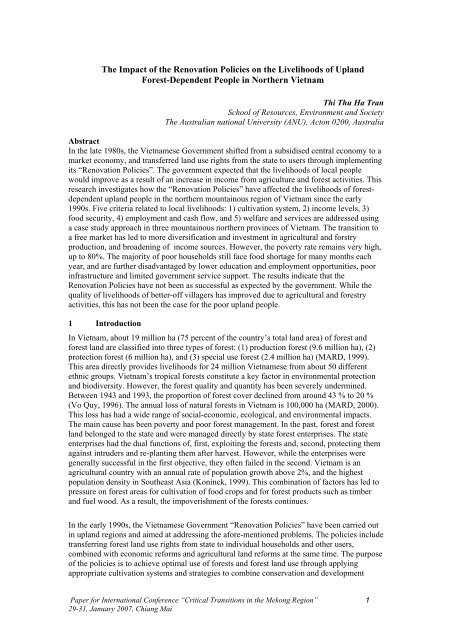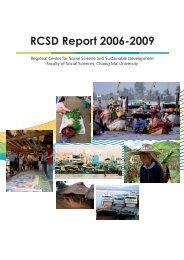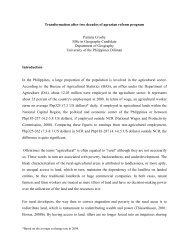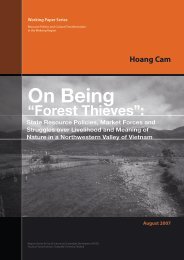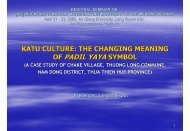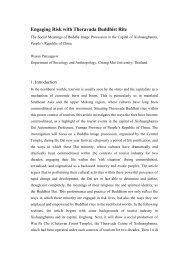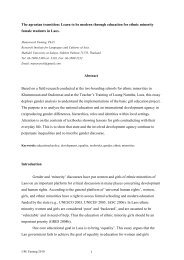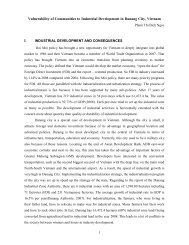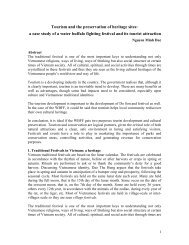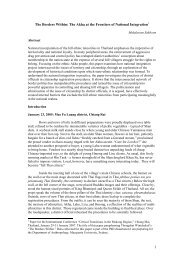The Impact of the Renovation Policies on the Livelihoods of ... - RCSD
The Impact of the Renovation Policies on the Livelihoods of ... - RCSD
The Impact of the Renovation Policies on the Livelihoods of ... - RCSD
You also want an ePaper? Increase the reach of your titles
YUMPU automatically turns print PDFs into web optimized ePapers that Google loves.
<str<strong>on</strong>g>The</str<strong>on</strong>g> <str<strong>on</strong>g>Impact</str<strong>on</strong>g> <str<strong>on</strong>g>of</str<strong>on</strong>g> <str<strong>on</strong>g>the</str<strong>on</strong>g> <str<strong>on</strong>g>Renovati<strong>on</strong></str<strong>on</strong>g> <str<strong>on</strong>g>Policies</str<strong>on</strong>g> <strong>on</strong> <str<strong>on</strong>g>the</str<strong>on</strong>g> <strong>Livelihoods</strong> <str<strong>on</strong>g>of</str<strong>on</strong>g> UplandForest-Dependent People in Nor<str<strong>on</strong>g>the</str<strong>on</strong>g>rn VietnamThi Thu Ha TranSchool <str<strong>on</strong>g>of</str<strong>on</strong>g> Resources, Envir<strong>on</strong>ment and Society<str<strong>on</strong>g>The</str<strong>on</strong>g> Australian nati<strong>on</strong>al University (ANU), Act<strong>on</strong> 0200, AustraliaAbstractIn <str<strong>on</strong>g>the</str<strong>on</strong>g> late 1980s, <str<strong>on</strong>g>the</str<strong>on</strong>g> Vietnamese Government shifted from a subsidised central ec<strong>on</strong>omy to amarket ec<strong>on</strong>omy, and transferred land use rights from <str<strong>on</strong>g>the</str<strong>on</strong>g> state to users through implementingits “<str<strong>on</strong>g>Renovati<strong>on</strong></str<strong>on</strong>g> <str<strong>on</strong>g>Policies</str<strong>on</strong>g>”. <str<strong>on</strong>g>The</str<strong>on</strong>g> government expected that <str<strong>on</strong>g>the</str<strong>on</strong>g> livelihoods <str<strong>on</strong>g>of</str<strong>on</strong>g> local peoplewould improve as a result <str<strong>on</strong>g>of</str<strong>on</strong>g> an increase in income from agriculture and forest activities. Thisresearch investigates how <str<strong>on</strong>g>the</str<strong>on</strong>g> “<str<strong>on</strong>g>Renovati<strong>on</strong></str<strong>on</strong>g> <str<strong>on</strong>g>Policies</str<strong>on</strong>g>” have affected <str<strong>on</strong>g>the</str<strong>on</strong>g> livelihoods <str<strong>on</strong>g>of</str<strong>on</strong>g> forestdependentupland people in <str<strong>on</strong>g>the</str<strong>on</strong>g> nor<str<strong>on</strong>g>the</str<strong>on</strong>g>rn mountainous regi<strong>on</strong> <str<strong>on</strong>g>of</str<strong>on</strong>g> Vietnam since <str<strong>on</strong>g>the</str<strong>on</strong>g> early1990s. Five criteria related to local livelihoods: 1) cultivati<strong>on</strong> system, 2) income levels, 3)food security, 4) employment and cash flow, and 5) welfare and services are addressed usinga case study approach in three mountainous nor<str<strong>on</strong>g>the</str<strong>on</strong>g>rn provinces <str<strong>on</strong>g>of</str<strong>on</strong>g> Vietnam. <str<strong>on</strong>g>The</str<strong>on</strong>g> transiti<strong>on</strong> toa free market has led to more diversificati<strong>on</strong> and investment in agricultural and forstryproducti<strong>on</strong>, and broadening <str<strong>on</strong>g>of</str<strong>on</strong>g> income sources. However, <str<strong>on</strong>g>the</str<strong>on</strong>g> poverty rate remains very high,up to 80%. <str<strong>on</strong>g>The</str<strong>on</strong>g> majority <str<strong>on</strong>g>of</str<strong>on</strong>g> poor households still face food shortage for many m<strong>on</strong>ths eachyear, and are fur<str<strong>on</strong>g>the</str<strong>on</strong>g>r disadvantaged by lower educati<strong>on</strong> and employment opportunities, poorinfrastructure and limited government service support. <str<strong>on</strong>g>The</str<strong>on</strong>g> results indicate that <str<strong>on</strong>g>the</str<strong>on</strong>g><str<strong>on</strong>g>Renovati<strong>on</strong></str<strong>on</strong>g> <str<strong>on</strong>g>Policies</str<strong>on</strong>g> have not been as successful as expected by <str<strong>on</strong>g>the</str<strong>on</strong>g> government. While <str<strong>on</strong>g>the</str<strong>on</strong>g>quality <str<strong>on</strong>g>of</str<strong>on</strong>g> livelihoods <str<strong>on</strong>g>of</str<strong>on</strong>g> better-<str<strong>on</strong>g>of</str<strong>on</strong>g>f villagers has improved due to agricultural and forestryactivities, this has not been <str<strong>on</strong>g>the</str<strong>on</strong>g> case for <str<strong>on</strong>g>the</str<strong>on</strong>g> poor upland people.1 Introducti<strong>on</strong>In Vietnam, about 19 milli<strong>on</strong> ha (75 percent <str<strong>on</strong>g>of</str<strong>on</strong>g> <str<strong>on</strong>g>the</str<strong>on</strong>g> country’s total land area) <str<strong>on</strong>g>of</str<strong>on</strong>g> forest andforest land are classified into three types <str<strong>on</strong>g>of</str<strong>on</strong>g> forest: (1) producti<strong>on</strong> forest (9.6 milli<strong>on</strong> ha), (2)protecti<strong>on</strong> forest (6 milli<strong>on</strong> ha), and (3) special use forest (2.4 milli<strong>on</strong> ha) (MARD, 1999).This area directly provides livelihoods for 24 milli<strong>on</strong> Vietnamese from about 50 differentethnic groups. Vietnam’s tropical forests c<strong>on</strong>stitute a key factor in envir<strong>on</strong>mental protecti<strong>on</strong>and biodiversity. However, <str<strong>on</strong>g>the</str<strong>on</strong>g> forest quality and quantity has been severely undermined.Between 1943 and 1993, <str<strong>on</strong>g>the</str<strong>on</strong>g> proporti<strong>on</strong> <str<strong>on</strong>g>of</str<strong>on</strong>g> forest cover declined from around 43 % to 20 %(Vo Quy, 1996). <str<strong>on</strong>g>The</str<strong>on</strong>g> annual loss <str<strong>on</strong>g>of</str<strong>on</strong>g> natural forests in Vietnam is 100,000 ha (MARD, 2000).This loss has had a wide range <str<strong>on</strong>g>of</str<strong>on</strong>g> social-ec<strong>on</strong>omic, ecological, and envir<strong>on</strong>mental impacts.<str<strong>on</strong>g>The</str<strong>on</strong>g> main cause has been poverty and poor forest management. In <str<strong>on</strong>g>the</str<strong>on</strong>g> past, forest and forestland bel<strong>on</strong>ged to <str<strong>on</strong>g>the</str<strong>on</strong>g> state and were managed directly by state forest enterprises. <str<strong>on</strong>g>The</str<strong>on</strong>g> stateenterprises had <str<strong>on</strong>g>the</str<strong>on</strong>g> dual functi<strong>on</strong>s <str<strong>on</strong>g>of</str<strong>on</strong>g>, first, exploiting <str<strong>on</strong>g>the</str<strong>on</strong>g> forests and, sec<strong>on</strong>d, protecting <str<strong>on</strong>g>the</str<strong>on</strong>g>magainst intruders and re-planting <str<strong>on</strong>g>the</str<strong>on</strong>g>m after harvest. However, while <str<strong>on</strong>g>the</str<strong>on</strong>g> enterprises weregenerally successful in <str<strong>on</strong>g>the</str<strong>on</strong>g> first objective, <str<strong>on</strong>g>the</str<strong>on</strong>g>y <str<strong>on</strong>g>of</str<strong>on</strong>g>ten failed in <str<strong>on</strong>g>the</str<strong>on</strong>g> sec<strong>on</strong>d. Vietnam is anagricultural country with an annual rate <str<strong>on</strong>g>of</str<strong>on</strong>g> populati<strong>on</strong> growth above 2%, and <str<strong>on</strong>g>the</str<strong>on</strong>g> highestpopulati<strong>on</strong> density in Sou<str<strong>on</strong>g>the</str<strong>on</strong>g>ast Asia (K<strong>on</strong>inck, 1999). This combinati<strong>on</strong> <str<strong>on</strong>g>of</str<strong>on</strong>g> factors has led topressure <strong>on</strong> forest areas for cultivati<strong>on</strong> <str<strong>on</strong>g>of</str<strong>on</strong>g> food crops and for forest products such as timberand fuel wood. As a result, <str<strong>on</strong>g>the</str<strong>on</strong>g> impoverishment <str<strong>on</strong>g>of</str<strong>on</strong>g> <str<strong>on</strong>g>the</str<strong>on</strong>g> forests c<strong>on</strong>tinues.In <str<strong>on</strong>g>the</str<strong>on</strong>g> early 1990s, <str<strong>on</strong>g>the</str<strong>on</strong>g> Vietnamese Government “<str<strong>on</strong>g>Renovati<strong>on</strong></str<strong>on</strong>g> <str<strong>on</strong>g>Policies</str<strong>on</strong>g>” have been carried outin upland regi<strong>on</strong>s and aimed at addressing <str<strong>on</strong>g>the</str<strong>on</strong>g> afore-menti<strong>on</strong>ed problems. <str<strong>on</strong>g>The</str<strong>on</strong>g> policies includetransferring forest land use rights from state to individual households and o<str<strong>on</strong>g>the</str<strong>on</strong>g>r users,combined with ec<strong>on</strong>omic reforms and agricultural land reforms at <str<strong>on</strong>g>the</str<strong>on</strong>g> same time. <str<strong>on</strong>g>The</str<strong>on</strong>g> purpose<str<strong>on</strong>g>of</str<strong>on</strong>g> <str<strong>on</strong>g>the</str<strong>on</strong>g> policies is to achieve optimal use <str<strong>on</strong>g>of</str<strong>on</strong>g> forests and forest land use through applyingappropriate cultivati<strong>on</strong> systems and strategies to combine c<strong>on</strong>servati<strong>on</strong> and developmentPaper for Internati<strong>on</strong>al C<strong>on</strong>ference “Critical Transiti<strong>on</strong>s in <str<strong>on</strong>g>the</str<strong>on</strong>g> Mek<strong>on</strong>g Regi<strong>on</strong>” 129-31, January 2007, Chiang Mai
goals in <str<strong>on</strong>g>the</str<strong>on</strong>g> upland areas, in <str<strong>on</strong>g>the</str<strong>on</strong>g> hope <str<strong>on</strong>g>of</str<strong>on</strong>g> increasing <str<strong>on</strong>g>the</str<strong>on</strong>g> income <str<strong>on</strong>g>of</str<strong>on</strong>g> upland people, timber andn<strong>on</strong>-timber products, protecti<strong>on</strong> <str<strong>on</strong>g>of</str<strong>on</strong>g> ecological systems and envir<strong>on</strong>mental benefits. It wasexpected by <str<strong>on</strong>g>the</str<strong>on</strong>g> government that, by increasing local income based <strong>on</strong> appropriate agriculturaland forestry producti<strong>on</strong> activities, deforestati<strong>on</strong> would be stopped and sloping land would bemanaged sustainably. However, so far <str<strong>on</strong>g>the</str<strong>on</strong>g> results <str<strong>on</strong>g>of</str<strong>on</strong>g> <str<strong>on</strong>g>the</str<strong>on</strong>g> policies have not really met <str<strong>on</strong>g>the</str<strong>on</strong>g>objectives above (Kerkvliet and Poster 1995; Goletti and Minot 1997; Morris<strong>on</strong> and Dubois1998; ADB 2000; Le Tr<strong>on</strong>g Cuc and Rambo, 2001; Al<str<strong>on</strong>g>the</str<strong>on</strong>g>r et al. 2002; Zingerli et al. 2002).My research asks <str<strong>on</strong>g>the</str<strong>on</strong>g> questi<strong>on</strong> “What impact have <str<strong>on</strong>g>the</str<strong>on</strong>g> <str<strong>on</strong>g>Renovati<strong>on</strong></str<strong>on</strong>g> <str<strong>on</strong>g>Policies</str<strong>on</strong>g> (Doi Moi) had <strong>on</strong>local livelihoods in <str<strong>on</strong>g>the</str<strong>on</strong>g> nor<str<strong>on</strong>g>the</str<strong>on</strong>g>rn mountainous regi<strong>on</strong> <str<strong>on</strong>g>of</str<strong>on</strong>g> Vietnam?” This is an importantquesti<strong>on</strong> because it challenges <str<strong>on</strong>g>the</str<strong>on</strong>g> success or failure <str<strong>on</strong>g>of</str<strong>on</strong>g> <str<strong>on</strong>g>Renovati<strong>on</strong></str<strong>on</strong>g> <str<strong>on</strong>g>Policies</str<strong>on</strong>g> which have set inmoti<strong>on</strong> a strategy <str<strong>on</strong>g>of</str<strong>on</strong>g> sustainable development in <str<strong>on</strong>g>the</str<strong>on</strong>g> uplands <str<strong>on</strong>g>of</str<strong>on</strong>g> Vietnam since <str<strong>on</strong>g>the</str<strong>on</strong>g> early 1990s.<str<strong>on</strong>g>The</str<strong>on</strong>g> answers to this questi<strong>on</strong> will provide <str<strong>on</strong>g>the</str<strong>on</strong>g> scientific foundati<strong>on</strong> for policy and decisi<strong>on</strong>makers to review <str<strong>on</strong>g>the</str<strong>on</strong>g> results <str<strong>on</strong>g>of</str<strong>on</strong>g> <str<strong>on</strong>g>the</str<strong>on</strong>g> renovati<strong>on</strong> policies, to apply appropriate approaches anddevelop <str<strong>on</strong>g>the</str<strong>on</strong>g>m fur<str<strong>on</strong>g>the</str<strong>on</strong>g>r in order to streng<str<strong>on</strong>g>the</str<strong>on</strong>g>n efforts towards sustainable development practicesin Vietnam.This paper presents <str<strong>on</strong>g>the</str<strong>on</strong>g> results <str<strong>on</strong>g>of</str<strong>on</strong>g> my research <strong>on</strong> local livehoods involving all three foresttypes - producti<strong>on</strong>, protecti<strong>on</strong> and special use.2. Methodology<str<strong>on</strong>g>The</str<strong>on</strong>g> research was carried out using an interdisciplinary approach with <str<strong>on</strong>g>the</str<strong>on</strong>g> major disciplinesbeing human geography, ecology, ec<strong>on</strong>omics, and social anthropology.2.1 Study sitesSix case studies were carried out in nor<str<strong>on</strong>g>the</str<strong>on</strong>g>rnthree provinces <str<strong>on</strong>g>of</str<strong>on</strong>g> Thai Nguyen, Bac Kanand Cao Bang, which represent a transectfrom Hanoi to <str<strong>on</strong>g>the</str<strong>on</strong>g> nor<str<strong>on</strong>g>the</str<strong>on</strong>g>rn border withChina and are representative <str<strong>on</strong>g>of</str<strong>on</strong>g> diferentforest types (Figure 1). Two case studieswere included for each province, with <strong>on</strong>ebeing located near a commune centre andclose to <str<strong>on</strong>g>the</str<strong>on</strong>g> lowlands and ano<str<strong>on</strong>g>the</str<strong>on</strong>g>r located in<str<strong>on</strong>g>the</str<strong>on</strong>g> remote uplands.<str<strong>on</strong>g>The</str<strong>on</strong>g> villages were Vau and Nac (ThaiNguyen) for producti<strong>on</strong> forest type, BanCam and Khau Qua (Bac Kan) for specialuse forest type and Pac Han and Khuoi Ken(Cao Bang) for protecti<strong>on</strong> forest type.Cao BangBac KanThai NguyenFigure 2.1. Map showing locati<strong>on</strong> <str<strong>on</strong>g>of</str<strong>on</strong>g> <str<strong>on</strong>g>the</str<strong>on</strong>g>three case study provinces in nor<str<strong>on</strong>g>the</str<strong>on</strong>g>rnVietnam2.2 Data collecti<strong>on</strong>To examine <str<strong>on</strong>g>the</str<strong>on</strong>g> impacts <str<strong>on</strong>g>of</str<strong>on</strong>g> <str<strong>on</strong>g>the</str<strong>on</strong>g> renovati<strong>on</strong> policies since <str<strong>on</strong>g>the</str<strong>on</strong>g> early 1990s <strong>on</strong> <str<strong>on</strong>g>the</str<strong>on</strong>g> livelihoods <str<strong>on</strong>g>of</str<strong>on</strong>g>upland people, relevant data and informati<strong>on</strong> were obtained for two periods: <str<strong>on</strong>g>the</str<strong>on</strong>g> early 1990sbefore <str<strong>on</strong>g>the</str<strong>on</strong>g> introducti<strong>on</strong> <str<strong>on</strong>g>of</str<strong>on</strong>g> <str<strong>on</strong>g>the</str<strong>on</strong>g> policies; and 2004-2005 after <str<strong>on</strong>g>the</str<strong>on</strong>g> introducti<strong>on</strong> <str<strong>on</strong>g>of</str<strong>on</strong>g> <str<strong>on</strong>g>the</str<strong>on</strong>g> policies.Both primary and sec<strong>on</strong>dary data were collected by <str<strong>on</strong>g>the</str<strong>on</strong>g> author during about 11 m<strong>on</strong>ths <str<strong>on</strong>g>of</str<strong>on</strong>g>fieldworks in 2005-2006.• Primary dataBoth qualitative and quantitative methods were used for collecting primary data. <str<strong>on</strong>g>The</str<strong>on</strong>g> threemain methods used were: (1) Group meetings and discussi<strong>on</strong>s using topic checklists werec<strong>on</strong>ducted from local to nati<strong>on</strong>al levels. Group discussi<strong>on</strong>s involving villagers, localPaper for Internati<strong>on</strong>al C<strong>on</strong>ference “Critical Transiti<strong>on</strong>s in <str<strong>on</strong>g>the</str<strong>on</strong>g> Mek<strong>on</strong>g Regi<strong>on</strong>” 229-31, January 2007, Chiang Mai
authorities, central government authorities, and internati<strong>on</strong>al agencies and NGOs (2)Interviews <str<strong>on</strong>g>of</str<strong>on</strong>g> key informants (local authorities) were based <strong>on</strong> a set <str<strong>on</strong>g>of</str<strong>on</strong>g> topic checklists andopen-ended questi<strong>on</strong>s; and (3) Key informant interviews and household surveys using semistructuredquesti<strong>on</strong>naires with a particular focus <strong>on</strong> cultivati<strong>on</strong> systems, income, foodsecurity, land use and opportunities to acess public services and markets by forest-dependantpeople. At least 40% <str<strong>on</strong>g>of</str<strong>on</strong>g> <str<strong>on</strong>g>the</str<strong>on</strong>g> total households in each case study village were selected based <strong>on</strong><str<strong>on</strong>g>the</str<strong>on</strong>g> wealth ranking within <str<strong>on</strong>g>the</str<strong>on</strong>g> village identified during group discussi<strong>on</strong>s. About 20 to 30 keyinformants from each case study were interviewed. <str<strong>on</strong>g>The</str<strong>on</strong>g> number <str<strong>on</strong>g>of</str<strong>on</strong>g> informants at differentlevels (village, district, and province) involved in group discussi<strong>on</strong>s is shown in Table 1.Table 1: Number <str<strong>on</strong>g>of</str<strong>on</strong>g> interviews c<strong>on</strong>ducted to obtain primary dataLocati<strong>on</strong> Household Key informant(village)Key informant(commune)Government(district, province)Thai Nguyen 22 (Vau)40 20 2040 (Nac)Bac Kan 17 (Khau Qua) 40 10 2024 (Ban Cam)Cao Bang 18 (Pac Han)30 10 2015 (Khuoi Ken)Total 136 110 40 60• Sec<strong>on</strong>dary dataSec<strong>on</strong>dary data recorded before 1990s up to 2005 by various government agencies, GOs,NGOs and o<str<strong>on</strong>g>the</str<strong>on</strong>g>r studies were collected. <str<strong>on</strong>g>The</str<strong>on</strong>g>se data include: (1) Documentati<strong>on</strong> <strong>on</strong> policies,laws, decisi<strong>on</strong>s, planning and management strategies, and reports; and (2) Statistics <strong>on</strong> socioec<strong>on</strong>omicaspects.3. Results3.1 Change in upland cultivati<strong>on</strong> system3.1.1 Change in land useIn total, 125 households in <str<strong>on</strong>g>the</str<strong>on</strong>g> six case-study villages were surveyed for <str<strong>on</strong>g>the</str<strong>on</strong>g> present study.Members <str<strong>on</strong>g>of</str<strong>on</strong>g> <str<strong>on</strong>g>the</str<strong>on</strong>g>se households have lived c<strong>on</strong>tinuously in <str<strong>on</strong>g>the</str<strong>on</strong>g>se villages since before <str<strong>on</strong>g>the</str<strong>on</strong>g>1990s.Before <str<strong>on</strong>g>the</str<strong>on</strong>g> renovati<strong>on</strong> began in <str<strong>on</strong>g>the</str<strong>on</strong>g> early 1990s, forest land was managed by <str<strong>on</strong>g>the</str<strong>on</strong>g> governmentbut in <str<strong>on</strong>g>the</str<strong>on</strong>g> views <str<strong>on</strong>g>of</str<strong>on</strong>g> villagers, forest land was comm<strong>on</strong> land that <str<strong>on</strong>g>the</str<strong>on</strong>g>y could simply access forshifting cultivati<strong>on</strong>. In some places like Khuoi Ken, forest land was managed by a collectivebut villagers also treated it as comm<strong>on</strong> land. In additi<strong>on</strong>, <str<strong>on</strong>g>the</str<strong>on</strong>g> government’s strategy for foodself sufficiency in 1980-1990 resulted in upland people trying to maximize food cropproducti<strong>on</strong> through shifting cultivati<strong>on</strong>. <str<strong>on</strong>g>The</str<strong>on</strong>g> main c<strong>on</strong>sequences <str<strong>on</strong>g>of</str<strong>on</strong>g> shifting cultivati<strong>on</strong> wereloss <str<strong>on</strong>g>of</str<strong>on</strong>g> forest and subsequent soil erosi<strong>on</strong>. In <str<strong>on</strong>g>the</str<strong>on</strong>g> early 1990s, <str<strong>on</strong>g>the</str<strong>on</strong>g> government’s renovati<strong>on</strong>strategy for <str<strong>on</strong>g>the</str<strong>on</strong>g> upland regi<strong>on</strong> led to changes in <str<strong>on</strong>g>the</str<strong>on</strong>g> crop cultivati<strong>on</strong> systems, to promotegreater ec<strong>on</strong>omic efficiency and respect for envir<strong>on</strong>mental values. <str<strong>on</strong>g>The</str<strong>on</strong>g> cultivati<strong>on</strong> systems inmost <str<strong>on</strong>g>of</str<strong>on</strong>g> <str<strong>on</strong>g>the</str<strong>on</strong>g> case study areas have changed as a result (see Table 2).Paper for Internati<strong>on</strong>al C<strong>on</strong>ference “Critical Transiti<strong>on</strong>s in <str<strong>on</strong>g>the</str<strong>on</strong>g> Mek<strong>on</strong>g Regi<strong>on</strong>” 329-31, January 2007, Chiang Mai
Table 2: Change in land use 1994-2005 for households in six case study villagesVillageNo.<str<strong>on</strong>g>of</str<strong>on</strong>g> hPaddy rice (equal 1 crop)(m 2 )O<str<strong>on</strong>g>the</str<strong>on</strong>g>r agricultural land (equal1 crop) (m 2 )Upland field for dry food crops(m 2 )Cash crops(m 2 )Forest plantati<strong>on</strong>(ha)1992 2005 change 1992 2005 change 1992 2005 change 1992 2005 change 19922005 changeThai NguyenVau 20 30,660 34,660 + 4,000 2,000 7,200 + 5,200 575,000 10,860 - 564,140 0 50,570+50,570 0 13 + 13Nac 34 80,916 89,860 + 8,944 0 0 02,838,000360,300-2,477,700 0120,080+120,080 0 370 +370Bac KanBan Cam 22 45,250 74,200+28,950 58,100 116,200+58,100 310,000 41,000 - 269,000 0 0 0 0 0 0Khau Qua 16 70,000 87,500Cao Bang+17,500 0 0 0 305,000250,200 - 54,800 0 0 0 0 0 0Pac Han 18 12,960 13,680 + 720206,080 177,480-28,600 50,000 o -50,000 0 13,600+13,600 0 1.5 + 1.5KhuoiKen 15 1,200 15,200+14,000 0 0 0 655,000195,600 - 459,400 0 33,700+33,700 0 18.5 + 18.5Total 125 240,986315,100+74,114266,180 300,880 29,5004,683,000857,960-3,825,040 0217,950+217,950 0 403 + 403Paper for Internati<strong>on</strong>al C<strong>on</strong>ference “Critical Transiti<strong>on</strong>s in <str<strong>on</strong>g>the</str<strong>on</strong>g> Mek<strong>on</strong>g Regi<strong>on</strong>” 429-31, January 2007, Chiang Mai
<str<strong>on</strong>g>The</str<strong>on</strong>g>re have been marked changes in land use since <str<strong>on</strong>g>the</str<strong>on</strong>g> land reform. <str<strong>on</strong>g>The</str<strong>on</strong>g> area <str<strong>on</strong>g>of</str<strong>on</strong>g> paddy (rice fields)increased in most villages, but for different reas<strong>on</strong>s. First, areas near streams were turned intosloping paddy fields in Vau, Nac, Khuoi Ken, and Khau Qua. Sec<strong>on</strong>dly, some people boughtpaddy rice areas from Tay (ethnic minority) people in Khuoi Ken and Khau Qua who did not live<str<strong>on</strong>g>the</str<strong>on</strong>g>re but had owned <str<strong>on</strong>g>the</str<strong>on</strong>g>se paddy lands for a l<strong>on</strong>g time. <str<strong>on</strong>g>The</str<strong>on</strong>g> paddy rice area in Ban Cam has notincreased since <str<strong>on</strong>g>the</str<strong>on</strong>g> 1990s, but land use has intensified, from <strong>on</strong>e crop to two crops per year byusing irrigati<strong>on</strong>. Most <str<strong>on</strong>g>of</str<strong>on</strong>g> <str<strong>on</strong>g>the</str<strong>on</strong>g> 45,250 m 2 <str<strong>on</strong>g>of</str<strong>on</strong>g> paddy rice areas in Ban Cam in 1994 were cultivatedfor two crops in 2005, an equivalent <str<strong>on</strong>g>of</str<strong>on</strong>g> 74,200 m 2 <strong>on</strong>e crop (see Table 2)O<str<strong>on</strong>g>the</str<strong>on</strong>g>r agricultural land 1 classified as plain land for dry food crops has increased in area, in BanCam (+58,100 m 2 ) and Vau (+5,200 m 2 ) (Table 2). In Vau <str<strong>on</strong>g>the</str<strong>on</strong>g> increase was <str<strong>on</strong>g>the</str<strong>on</strong>g> result <str<strong>on</strong>g>of</str<strong>on</strong>g> two-cropcultivati<strong>on</strong> in small plots near rivers and streams.In c<strong>on</strong>trast, upland areas for dry food crops such as upland rice, maize, cassava and beans havereduced significantly in most cases. During <str<strong>on</strong>g>the</str<strong>on</strong>g> 1980s-1990s, <str<strong>on</strong>g>the</str<strong>on</strong>g> forest land area was used forupland rice and maize cultivati<strong>on</strong> in most villages to satisfy <str<strong>on</strong>g>the</str<strong>on</strong>g> staple diet for local livelihoods.<str<strong>on</strong>g>The</str<strong>on</strong>g> survey data from 2005 (Table 2) shows that <str<strong>on</strong>g>the</str<strong>on</strong>g> areas used for shifting cultivati<strong>on</strong> in <str<strong>on</strong>g>the</str<strong>on</strong>g>1990s had, in most villages, reduced by 2005. For example, <str<strong>on</strong>g>the</str<strong>on</strong>g> shifting cultivati<strong>on</strong> area used inVau by 20 households was reduced from 575,000 m 2 in <str<strong>on</strong>g>the</str<strong>on</strong>g> 1990s to 10,860 m 2 in 2005.Similarly, <str<strong>on</strong>g>the</str<strong>on</strong>g> shifting cultivati<strong>on</strong> area in Nac used by 34 households was reduced from 2,838,000m 2 in <str<strong>on</strong>g>the</str<strong>on</strong>g> 1990s to 360,300 m 2 in 2005. At present, upland rice and maize (corn) are still beingcultivated in <str<strong>on</strong>g>the</str<strong>on</strong>g>se villages as <str<strong>on</strong>g>the</str<strong>on</strong>g> main food source, especially by <str<strong>on</strong>g>the</str<strong>on</strong>g> poor people who lack paddyrice land or lack <str<strong>on</strong>g>the</str<strong>on</strong>g> capacity to develop cash crops.Cash crop and plantati<strong>on</strong> areas were expanded in <str<strong>on</strong>g>the</str<strong>on</strong>g> last five years in most study villages exceptin Vau village where tea plantati<strong>on</strong>s had been developed earlier in 1994 under a resettlementproject. Most areas previously under shifting cultivati<strong>on</strong> were allocated to individual householdsfor reforestati<strong>on</strong>. However, <str<strong>on</strong>g>the</str<strong>on</strong>g> villagers elected to plant cash crops, including short-term crops(e.g. Thach Den - grass jelly) and l<strong>on</strong>g-term crops (e.g. tea) or commercial trees that providehigher ec<strong>on</strong>omic returns than forest trees or naturally regenerated forests <strong>on</strong> <str<strong>on</strong>g>the</str<strong>on</strong>g>se areas.3.1.2 Changes in crops and animal husbandrySince <str<strong>on</strong>g>the</str<strong>on</strong>g> introducti<strong>on</strong> <str<strong>on</strong>g>of</str<strong>on</strong>g> <str<strong>on</strong>g>the</str<strong>on</strong>g> land allocati<strong>on</strong> policy, upland people have had land use rights. <str<strong>on</strong>g>The</str<strong>on</strong>g>yare now more c<strong>on</strong>fident about investing labour and capital in <str<strong>on</strong>g>the</str<strong>on</strong>g>ir land for household ec<strong>on</strong>omicdevelopment. Shifting cultivati<strong>on</strong> was prohibited under <str<strong>on</strong>g>the</str<strong>on</strong>g> forest protecti<strong>on</strong> law and <str<strong>on</strong>g>the</str<strong>on</strong>g>regulati<strong>on</strong>s <strong>on</strong> forest land allocati<strong>on</strong> to households. Thus, upland people have had to re-organize<str<strong>on</strong>g>the</str<strong>on</strong>g>ir producti<strong>on</strong> by selecting alternative crops and animals which are appropriate to <str<strong>on</strong>g>the</str<strong>on</strong>g>irresources, such as soil c<strong>on</strong>diti<strong>on</strong>, labour, and investment abilities, and to markets and marketaccess.As show in Table 3, <str<strong>on</strong>g>the</str<strong>on</strong>g>re have been c<strong>on</strong>siderable changes in agricultural and forestry cultivati<strong>on</strong>in most case study villages since <str<strong>on</strong>g>the</str<strong>on</strong>g> renovati<strong>on</strong> policies came into effect.1 Agricultural land is characterised by < 8° <str<strong>on</strong>g>of</str<strong>on</strong>g> <str<strong>on</strong>g>the</str<strong>on</strong>g> slope.Paper for Internati<strong>on</strong>al C<strong>on</strong>ference “Critical Transiti<strong>on</strong>s in <str<strong>on</strong>g>the</str<strong>on</strong>g> Mek<strong>on</strong>g Regi<strong>on</strong>”29-31 January, 2007, Chiang Mai5
Table 3: Changes in cultivati<strong>on</strong> system in <str<strong>on</strong>g>the</str<strong>on</strong>g> six case study villages since Doi Moi policiesCultivati<strong>on</strong> type Before 1990s 20051. Food cropsPaddy riceFew traditi<strong>on</strong>al varieties with More varieties with high yieldsvery low yields for household Intensive investment in fertilizers,c<strong>on</strong>sumpti<strong>on</strong>own c<strong>on</strong>sumpti<strong>on</strong>Upland riceO<str<strong>on</strong>g>the</str<strong>on</strong>g>r crops (maize,beans, peanuts)2. Cash crops (tea, ThachDen- Grass Jelly)Most households had largeareas for own c<strong>on</strong>sumpti<strong>on</strong>Many local varieties with verylow yields, householdc<strong>on</strong>sumpti<strong>on</strong> <strong>on</strong>lyN<strong>on</strong>eFew households cultivating rice;small area for own c<strong>on</strong>sumpti<strong>on</strong>More varieties with high yields;intensive investment in fertilizers,own c<strong>on</strong>sumpti<strong>on</strong>Small to large plots, mainlycommercial3. Fruit trees N<strong>on</strong>e to few trees near houses New varieties/cl<strong>on</strong>es, mainlycommercial4. Commercial tree N<strong>on</strong>eplantati<strong>on</strong>5. Animal husbandry Few traditi<strong>on</strong>al breeds(chicken, ducks, few cattle) forMany new plantati<strong>on</strong>s,commercialMany new breeds for householdand commercial usehousehold c<strong>on</strong>sumpti<strong>on</strong>Note: No cash crops and commercial tree plantati<strong>on</strong> in Ban Cam and Khau Qua because <str<strong>on</strong>g>of</str<strong>on</strong>g> <str<strong>on</strong>g>the</str<strong>on</strong>g>restricti<strong>on</strong> under special use forest - Ba Be Nati<strong>on</strong>al Park<str<strong>on</strong>g>The</str<strong>on</strong>g> transiti<strong>on</strong> from self-sufficiency to a free market has led to more diversificati<strong>on</strong> <str<strong>on</strong>g>of</str<strong>on</strong>g> agriculturaland forestry producti<strong>on</strong> in most upland villages. <str<strong>on</strong>g>The</str<strong>on</strong>g> main products are not <strong>on</strong>ly food crops, butinclude many different kinds <str<strong>on</strong>g>of</str<strong>on</strong>g> cash crops, both short-term and l<strong>on</strong>g-term crops and commercialtrees. In additi<strong>on</strong>, animal husbandry has been developed for both household c<strong>on</strong>sumpti<strong>on</strong> andcommercial purposes. Moreover, upland people now have more freedom to trade forest products,including timber and n<strong>on</strong>-timber from <str<strong>on</strong>g>the</str<strong>on</strong>g>ir own forests, in <str<strong>on</strong>g>the</str<strong>on</strong>g> market. <str<strong>on</strong>g>The</str<strong>on</strong>g>se products areimportant in terms <str<strong>on</strong>g>of</str<strong>on</strong>g> employment, food, fodder and income to <str<strong>on</strong>g>the</str<strong>on</strong>g> local people, for bothhousehold c<strong>on</strong>sumpti<strong>on</strong> and trade. <str<strong>on</strong>g>The</str<strong>on</strong>g> diversificati<strong>on</strong> <str<strong>on</strong>g>of</str<strong>on</strong>g> products presents opportunities to raiseincomes. This has been encouraged by <str<strong>on</strong>g>the</str<strong>on</strong>g> provisi<strong>on</strong> <str<strong>on</strong>g>of</str<strong>on</strong>g> both good informati<strong>on</strong> about <str<strong>on</strong>g>the</str<strong>on</strong>g> market,and incentives to participate in <str<strong>on</strong>g>the</str<strong>on</strong>g> market ec<strong>on</strong>omy. However, diversificati<strong>on</strong> has been limited inthose villages located far from market centres like Nac, Khuoi Ken and Khau Qua.3.2 Income3.2.1 Income at provincial levelOverall, average income per pers<strong>on</strong> per m<strong>on</strong>th in <str<strong>on</strong>g>the</str<strong>on</strong>g> three provinces increased during 1995-1999and again in 1999-2003 (sees Figure 2). For example, in Thai Nguyen, <str<strong>on</strong>g>the</str<strong>on</strong>g> average incomeincreased c<strong>on</strong>siderably from 155,000 VND to 196,000 VND during 1995-1999 but <strong>on</strong>ly slightlyfrom 196,000 VND to 230,000 VND during 1999-2003. Similarly in Cao Bang, income increasedrapidly from 120,000 VND in 1995 to 209,000 VND in 1999 but more slowly average from209,000 VND in 1999 to 238,000 VND in 2003.Paper for Internati<strong>on</strong>al C<strong>on</strong>ference “Critical Transiti<strong>on</strong>s in <str<strong>on</strong>g>the</str<strong>on</strong>g> Mek<strong>on</strong>g Regi<strong>on</strong>”29-31 January, 2007, Chiang Mai6
1,000VND/pers<strong>on</strong>/m<strong>on</strong>th300200100023823020919 621915513412 0931995 1999 2003Thai Nguyen Bac Kan Cao BangFigure 2: Change in average m<strong>on</strong>thly income per pers<strong>on</strong> during period 1996-2003 indifferent provincesSource: MARD, 2002; Statistic Office <str<strong>on</strong>g>of</str<strong>on</strong>g> Thai Nguyen in 2004; Statistic Office <str<strong>on</strong>g>of</str<strong>on</strong>g> Bac Kanprovince in 2003; and Statistic Office <str<strong>on</strong>g>of</str<strong>on</strong>g> Cao Bang in 2004<str<strong>on</strong>g>The</str<strong>on</strong>g> situati<strong>on</strong> is different in Bac Kan province where <str<strong>on</strong>g>the</str<strong>on</strong>g> average m<strong>on</strong>thly income per pers<strong>on</strong> wasvery low, <strong>on</strong>ly 93,000 VND in 1995. <str<strong>on</strong>g>The</str<strong>on</strong>g> income increased at a similar rate to Cao Bang during1995-1993, but <str<strong>on</strong>g>the</str<strong>on</strong>g> increase was much greater during 1999-2003 from 134,000 VND to 219,000VND. Bac Kan was a new province created in 1997 2 . It is <strong>on</strong>e <str<strong>on</strong>g>of</str<strong>on</strong>g> <str<strong>on</strong>g>the</str<strong>on</strong>g> poorest provinces in <str<strong>on</strong>g>the</str<strong>on</strong>g>country, and has received special support from <str<strong>on</strong>g>the</str<strong>on</strong>g> central government for infrastructuredevelopment which has led to a greater increase in annual income than for Cao Bang and ThaiNguyen during <str<strong>on</strong>g>the</str<strong>on</strong>g> period 1999-2003.However, annual inflati<strong>on</strong> has led to a reducti<strong>on</strong> in <str<strong>on</strong>g>the</str<strong>on</strong>g> true value <str<strong>on</strong>g>of</str<strong>on</strong>g> <str<strong>on</strong>g>the</str<strong>on</strong>g> VND. <str<strong>on</strong>g>The</str<strong>on</strong>g>refore, <str<strong>on</strong>g>the</str<strong>on</strong>g>increase in average income has not helped improve <str<strong>on</strong>g>the</str<strong>on</strong>g> livelihoods <str<strong>on</strong>g>of</str<strong>on</strong>g> people overall. Accordingto <str<strong>on</strong>g>the</str<strong>on</strong>g> new criteri<strong>on</strong>, rural people are poor if <str<strong>on</strong>g>the</str<strong>on</strong>g>ir average m<strong>on</strong>thly income per pers<strong>on</strong> is less than200,000 VND (appropriate 13 USD). According to this measure, <str<strong>on</strong>g>the</str<strong>on</strong>g> proporti<strong>on</strong> <str<strong>on</strong>g>of</str<strong>on</strong>g> poor people in2005 increased to very high levels in all <str<strong>on</strong>g>the</str<strong>on</strong>g> three provinces. Many minority people living inhamlets/villages in <str<strong>on</strong>g>the</str<strong>on</strong>g>se provinces like H’M<strong>on</strong>g and Dao have a poverty rate <str<strong>on</strong>g>of</str<strong>on</strong>g> 90-100% under<str<strong>on</strong>g>the</str<strong>on</strong>g> new criteri<strong>on</strong>.3.2.2 Income <str<strong>on</strong>g>of</str<strong>on</strong>g> village people in different case study areas• Overall incomeAverage m<strong>on</strong>thly income per pers<strong>on</strong> in <str<strong>on</strong>g>the</str<strong>on</strong>g> six case study areas is presented in Figure 3.2 Before 1997 Bac Kan bel<strong>on</strong>ged to Bac Thai province which was subdivided into two provinces, ThaiNguyen and Bac Kan, in 1997.Paper for Internati<strong>on</strong>al C<strong>on</strong>ference “Critical Transiti<strong>on</strong>s in <str<strong>on</strong>g>the</str<strong>on</strong>g> Mek<strong>on</strong>g Regi<strong>on</strong>”29-31 January, 2007, Chiang Mai7
1000VND/pers<strong>on</strong>/m<strong>on</strong>th3002001000176128235192260Vau Nac Ban Cam Khau Qua Pac Han KhuoiKenProducti<strong>on</strong> forest Special use forest Protecti<strong>on</strong> forest150Figure 3: Average m<strong>on</strong>thly income per pers<strong>on</strong> in <str<strong>on</strong>g>the</str<strong>on</strong>g> six case studies<str<strong>on</strong>g>The</str<strong>on</strong>g>re are c<strong>on</strong>siderable differences in <str<strong>on</strong>g>the</str<strong>on</strong>g> average m<strong>on</strong>thly income per pers<strong>on</strong> in <str<strong>on</strong>g>the</str<strong>on</strong>g> different casestudy areas. Average income per pers<strong>on</strong> per m<strong>on</strong>th is very low; 128,000 VND in Nac, 171,000VND in Vau, and 150,000 VND in Khuoi Ken while it is much higher, at 260,000 VND in PacHan, 253,000 VND in Ban Cam and 192,000 VND in Khau Qua (see Figure 3). According to <str<strong>on</strong>g>the</str<strong>on</strong>g>government’s new criteri<strong>on</strong> for classificati<strong>on</strong> <str<strong>on</strong>g>of</str<strong>on</strong>g> <str<strong>on</strong>g>the</str<strong>on</strong>g> poor, <strong>on</strong>ly Pac Han and Ban Cam villageshave an average m<strong>on</strong>thly income per pers<strong>on</strong> above <str<strong>on</strong>g>the</str<strong>on</strong>g> poverty threshold. Each villager in Nacearns an equivalent <str<strong>on</strong>g>of</str<strong>on</strong>g> <strong>on</strong>ly 26 US cents per day.In <str<strong>on</strong>g>the</str<strong>on</strong>g> early 1990s, <str<strong>on</strong>g>the</str<strong>on</strong>g> average income <str<strong>on</strong>g>of</str<strong>on</strong>g> people in Thai Nguyen province, which is located nearHanoi, was higher than that <str<strong>on</strong>g>of</str<strong>on</strong>g> Bac Kan and Cao Bang. After ten years <str<strong>on</strong>g>of</str<strong>on</strong>g> renovati<strong>on</strong>, <str<strong>on</strong>g>the</str<strong>on</strong>g> income<str<strong>on</strong>g>of</str<strong>on</strong>g> <str<strong>on</strong>g>the</str<strong>on</strong>g> people in Bac Kan and Cao Bang has improved c<strong>on</strong>siderably and in 2005 <str<strong>on</strong>g>the</str<strong>on</strong>g> averageincome is higher than that in Thai Nguyen (Figure 3). <str<strong>on</strong>g>The</str<strong>on</strong>g> main reas<strong>on</strong> is that upland people inThai Nguyen have fewer valuable resources, suffer more competiti<strong>on</strong> in <str<strong>on</strong>g>the</str<strong>on</strong>g> markets, have highpopulati<strong>on</strong>s and no l<strong>on</strong>ger receive a subsidy from <str<strong>on</strong>g>the</str<strong>on</strong>g> government, while upland people in BacKan and Cao Bang have more available natural resources with a special subsidy (e.g. school fees,credit program, seed supply) from <str<strong>on</strong>g>the</str<strong>on</strong>g> government.• Income in different wealth ranking groups<str<strong>on</strong>g>The</str<strong>on</strong>g> average income discussed above does not show <str<strong>on</strong>g>the</str<strong>on</strong>g> full picture <str<strong>on</strong>g>of</str<strong>on</strong>g> <str<strong>on</strong>g>the</str<strong>on</strong>g> incomes <str<strong>on</strong>g>of</str<strong>on</strong>g> differenthousehold groups under <str<strong>on</strong>g>the</str<strong>on</strong>g> new free market system. <str<strong>on</strong>g>The</str<strong>on</strong>g>refore, income in different wealthranking groups is more informative. Three wealth ranking groups (very poor, poor and better-<str<strong>on</strong>g>of</str<strong>on</strong>g>f)are identified and classified based <strong>on</strong> local criteria, given in Table 4.Paper for Internati<strong>on</strong>al C<strong>on</strong>ference “Critical Transiti<strong>on</strong>s in <str<strong>on</strong>g>the</str<strong>on</strong>g> Mek<strong>on</strong>g Regi<strong>on</strong>”29-31 January, 2007, Chiang Mai8
Table 4: Criteria for different wealth ranking groupsVery poor Poor Better-<str<strong>on</strong>g>of</str<strong>on</strong>g>f- Bamboo house/temporary - Simple house - Good house/solid househouse- No valuable items in <str<strong>on</strong>g>the</str<strong>on</strong>g>house- Some furniture and smallappliances- Good furniture, many valuableitems- Small appliances, eg thresher,TV- Limited or no paddy ricearea- Limited or no paddy ricearea- Have paddy rice area (1000 m 2 )and upland field.- Lack <str<strong>on</strong>g>of</str<strong>on</strong>g> capital for crop - Lack <str<strong>on</strong>g>of</str<strong>on</strong>g> capital for crop - Have capital for crop investmentinvestmentinvestment- Own 0-1 cow/ buffalo - Own 1-2 cows/buffalo - Own 4-6 cows/ buffalo- Lack food for 6-10m<strong>on</strong>ths/year- Lack food for 2-3m<strong>on</strong>ths/year- Food security, excess food forsome m<strong>on</strong>ths <str<strong>on</strong>g>of</str<strong>on</strong>g> <str<strong>on</strong>g>the</str<strong>on</strong>g> year- Income less than 150,000VND/pers<strong>on</strong>/m<strong>on</strong>th- Income > 150,000 to 200,000VND/pers<strong>on</strong>/m<strong>on</strong>th- No savings, in debt from - No cash savings, in same - Have cash savingsbuying food <strong>on</strong> credit- Educati<strong>on</strong> up to primaryschool <strong>on</strong>lydebt- Educati<strong>on</strong> up to sec<strong>on</strong>daryschool- Educati<strong>on</strong> up to vocati<strong>on</strong>alschool level.Table 5 presents <str<strong>on</strong>g>the</str<strong>on</strong>g> proporti<strong>on</strong> <str<strong>on</strong>g>of</str<strong>on</strong>g> households in each wealth category as identified in Table 4. Inall <str<strong>on</strong>g>the</str<strong>on</strong>g> case study villages, poor and very poor people accounted for 50-80%. <str<strong>on</strong>g>The</str<strong>on</strong>g>re is a tendencytowards more poor people in remote villages (i.e. Nac, Khau Qua and Khuoi Ken) than in villageslocated near a commune or district centre (i.e. Vau, Ban Cam and Pac Han).Table 5: Percentage <str<strong>on</strong>g>of</str<strong>on</strong>g> households in <str<strong>on</strong>g>the</str<strong>on</strong>g> very poor, poor and better-<str<strong>on</strong>g>of</str<strong>on</strong>g>fcategories in <str<strong>on</strong>g>the</str<strong>on</strong>g> six case study villagesVillage Very poor (%) Poor (%) Better-<str<strong>on</strong>g>of</str<strong>on</strong>g>f (%)Vau 22.7 40.9 36.4Nac 45.6 36.6 13.8Ban Cam 19.7 36.0 44.3Khau Qua 36.4 39.4 24.2Pac Han 22.2 23.8 50.0Khuoi Ken 33.3 46.7 20.0My survey, showed a big gap in average m<strong>on</strong>thly income between <str<strong>on</strong>g>the</str<strong>on</strong>g> very poor and <str<strong>on</strong>g>the</str<strong>on</strong>g> better<str<strong>on</strong>g>of</str<strong>on</strong>g>f.<str<strong>on</strong>g>The</str<strong>on</strong>g> income <str<strong>on</strong>g>of</str<strong>on</strong>g> <str<strong>on</strong>g>the</str<strong>on</strong>g> better-<str<strong>on</strong>g>of</str<strong>on</strong>g>f is about three times higher than that <str<strong>on</strong>g>of</str<strong>on</strong>g> <str<strong>on</strong>g>the</str<strong>on</strong>g> very poor people inmost case studies (see Figure 4). Very poor people earn less than 112,000 VND per m<strong>on</strong>th in allcase study villages.Paper for Internati<strong>on</strong>al C<strong>on</strong>ference “Critical Transiti<strong>on</strong>s in <str<strong>on</strong>g>the</str<strong>on</strong>g> Mek<strong>on</strong>g Regi<strong>on</strong>”29-31 January, 2007, Chiang Mai9
4003713333351000VND/pers<strong>on</strong>/m<strong>on</strong>th30020010090179285235168 169180 180108 108 1128387172220Very poorPoorBetter-<str<strong>on</strong>g>of</str<strong>on</strong>g>f0Vau Nac Ban Cam Khau Qua Pac Han Khuoi KenProducti<strong>on</strong> forest Special use forest Protecti<strong>on</strong> forestFigure 4: Income according to wealth ranking group in study sites, by forest typeResults from household interviews using semi-structured questi<strong>on</strong>naires show that before <str<strong>on</strong>g>the</str<strong>on</strong>g>renovati<strong>on</strong> policies, most households in <str<strong>on</strong>g>the</str<strong>on</strong>g> villages experienced similar ec<strong>on</strong>omic c<strong>on</strong>diti<strong>on</strong>s, astypified by temporary houses, no goods <str<strong>on</strong>g>of</str<strong>on</strong>g> much value, low annual income, food insecurity, nocash savings, and little m<strong>on</strong>ey to invest in producti<strong>on</strong>. However, <str<strong>on</strong>g>the</str<strong>on</strong>g> classificati<strong>on</strong> <str<strong>on</strong>g>of</str<strong>on</strong>g> wealthranking by group in Table 4 and <str<strong>on</strong>g>the</str<strong>on</strong>g> m<strong>on</strong>thly income from Figure 4 show that after renovati<strong>on</strong>policies, m<strong>on</strong>thly income <str<strong>on</strong>g>of</str<strong>on</strong>g> better-<str<strong>on</strong>g>of</str<strong>on</strong>g>f people has improved while that <str<strong>on</strong>g>of</str<strong>on</strong>g> <str<strong>on</strong>g>the</str<strong>on</strong>g> poor people remainspoor.• Income sources* Income sources before 1990sDiscussi<strong>on</strong>s in <str<strong>on</strong>g>the</str<strong>on</strong>g> six case study villages show that <str<strong>on</strong>g>the</str<strong>on</strong>g> income sources <str<strong>on</strong>g>of</str<strong>on</strong>g> local people in <str<strong>on</strong>g>the</str<strong>on</strong>g>early 1990s comprised three main sources: food crop cultivati<strong>on</strong>, animal husbandry and forestproducts (Table 6).Table 6: Distributi<strong>on</strong> <str<strong>on</strong>g>of</str<strong>on</strong>g> income sources in <str<strong>on</strong>g>the</str<strong>on</strong>g> six case study villages before 1990sIncome sourceProducti<strong>on</strong> forest Special use forest Protecti<strong>on</strong> forestVau Nac Ban Khau Pac Khuoi KenCam Qua HanFood crops (%) 75 80 65 85 40 87Husbandry (%) 5 4 8 5 7 4Forest (%) 15 16 15 10 53 9O<str<strong>on</strong>g>the</str<strong>on</strong>g>rs (fishing) (%) - - 12 - - -Total (%) 100 100 100 100 100 100Food crops, particularly from shifting cultivati<strong>on</strong> provided <str<strong>on</strong>g>the</str<strong>on</strong>g> main income source before <str<strong>on</strong>g>the</str<strong>on</strong>g>1990s in most case study villages, except in Pac Han where <str<strong>on</strong>g>the</str<strong>on</strong>g> income from <str<strong>on</strong>g>the</str<strong>on</strong>g> forest wasgreatest. Traditi<strong>on</strong>al cultivati<strong>on</strong> by slash and burn expanded in most upland areas during that timeto maximize food crops to support subsistence.* Income sources in 2005In 2005, <str<strong>on</strong>g>the</str<strong>on</strong>g> income sources were more diverse than in 1990. Six main sources <str<strong>on</strong>g>of</str<strong>on</strong>g> income wererecorded: food crops, cash crops, husbandry, forestry activities, labouring and o<str<strong>on</strong>g>the</str<strong>on</strong>g>rs such asfishing, services, government salary, or project support (see Table 7).Paper for Internati<strong>on</strong>al C<strong>on</strong>ference “Critical Transiti<strong>on</strong>s in <str<strong>on</strong>g>the</str<strong>on</strong>g> Mek<strong>on</strong>g Regi<strong>on</strong>”29-31 January, 2007, Chiang Mai10
Table 7: Distributi<strong>on</strong> <str<strong>on</strong>g>of</str<strong>on</strong>g> different income sources in 2005Income sourceProducti<strong>on</strong> forest Special use forest Protecti<strong>on</strong> forestVau Nac Ban Khau Pac Khuoi KenCam Qua Han1. Food crops (%) 13.4 44.6 44.6 69.6 44.4 41.32. Cash crops (%) 54.6 13.9 0 0 0.8 24.73. Animal husbandry (%) 15.6 16.7 11.1 28.6 13.0 20.44. Forest (%) 8.7 12.7 3.3 1.1 40.1 11.05. Labouring (%) 2.8 5.1 0 0 0 06. O<str<strong>on</strong>g>the</str<strong>on</strong>g>rs (%) 1.0 2.9 41.0 0.7 1.7 2.4Total (%) 100 100 100 100 100 100Note: Labouring is farm labour; o<str<strong>on</strong>g>the</str<strong>on</strong>g>r work includes fishing, services, government payment forvillage/commune representatives, small shops.<str<strong>on</strong>g>The</str<strong>on</strong>g> income sources reported in most case study site sin 2005 differed from those recorded in <str<strong>on</strong>g>the</str<strong>on</strong>g>1990s. <str<strong>on</strong>g>The</str<strong>on</strong>g>re were three new income sources in 2005; cash crops, labouring and o<str<strong>on</strong>g>the</str<strong>on</strong>g>rs.Compared to <str<strong>on</strong>g>the</str<strong>on</strong>g> data for <str<strong>on</strong>g>the</str<strong>on</strong>g> 1990s, <str<strong>on</strong>g>the</str<strong>on</strong>g>re was a notable change in <str<strong>on</strong>g>the</str<strong>on</strong>g> income compositi<strong>on</strong> in2005 with a substantial drop in food crop producti<strong>on</strong>, and an increase in cash crop producti<strong>on</strong>(e.g. tea and Thach Den) and animal husbandry. Income from food crops was is still <str<strong>on</strong>g>the</str<strong>on</strong>g> mostimportant in all case studies except in Vau; however, o<str<strong>on</strong>g>the</str<strong>on</strong>g>r income sources had increased <str<strong>on</strong>g>the</str<strong>on</strong>g>irproporti<strong>on</strong> c<strong>on</strong>siderably. For example, new income from cash crops in Khuoi Ken accounted for24.7% in 2005, and o<str<strong>on</strong>g>the</str<strong>on</strong>g>r sources (boat services, fishing) in Ban Cam increased from 12% in <str<strong>on</strong>g>the</str<strong>on</strong>g>1990s to 41% in 2005.Market demand led villagers to change crop cultivati<strong>on</strong> systems very quickly after <str<strong>on</strong>g>the</str<strong>on</strong>g> renovati<strong>on</strong>process. Cash crops are a new source <str<strong>on</strong>g>of</str<strong>on</strong>g> income for many local people. Tea and ‘Thach Den’have become main cash crops in some case study villages. In Vau, income from cash crops (tea)accounted for 54% <str<strong>on</strong>g>of</str<strong>on</strong>g> total income while income from food crops decreased from 75% <str<strong>on</strong>g>of</str<strong>on</strong>g> totalincome in <str<strong>on</strong>g>the</str<strong>on</strong>g> 1990s to <strong>on</strong>ly 13.4% in 2005. Tea plays a very important role in <str<strong>on</strong>g>the</str<strong>on</strong>g> ec<strong>on</strong>omy <str<strong>on</strong>g>of</str<strong>on</strong>g> <str<strong>on</strong>g>the</str<strong>on</strong>g>upland area. Many households that have invested in tea planting no l<strong>on</strong>ger have paddy land orland for shifting cultivati<strong>on</strong>. <str<strong>on</strong>g>The</str<strong>on</strong>g>se cases, <str<strong>on</strong>g>the</str<strong>on</strong>g> income from tea products is used to purchases ricefor household c<strong>on</strong>sumpti<strong>on</strong>. Similarly, Thach Den c<strong>on</strong>tributed 24.7% to total income in KhuoiKen. It is also planted in small plots by a few households in Pac Han in early 2005. Large areaswere expected to be developed for Thach Den in <str<strong>on</strong>g>the</str<strong>on</strong>g> next few years.Livestock and poultry rising also provide examples <str<strong>on</strong>g>of</str<strong>on</strong>g> sources <str<strong>on</strong>g>of</str<strong>on</strong>g> important subsidiary incomewhich can be significant for households. <str<strong>on</strong>g>The</str<strong>on</strong>g>se provide <str<strong>on</strong>g>the</str<strong>on</strong>g> main source <str<strong>on</strong>g>of</str<strong>on</strong>g> cash income to payschool fees and for health care by many families.<str<strong>on</strong>g>The</str<strong>on</strong>g> income from forests has declined in most case study areas due to forest degradati<strong>on</strong> andstricter c<strong>on</strong>trol <str<strong>on</strong>g>of</str<strong>on</strong>g> illegal logging. In Pac Han village, income from <str<strong>on</strong>g>the</str<strong>on</strong>g> forests dropped from 53%in 1990s to 40.1% in 2005. Apart from Pac Han, this source c<strong>on</strong>tributed 1.1-12.7% in o<str<strong>on</strong>g>the</str<strong>on</strong>g>rvillages. In Pac Han, Nghien (Excentrodendr<strong>on</strong> t<strong>on</strong>kinense) is a high-value timber tree species.Nghien forest is classified as a special limest<strong>on</strong>e-mountainous forest for protecti<strong>on</strong> purposes. Infact, <str<strong>on</strong>g>the</str<strong>on</strong>g> whole Nghien forest has been allocated to households in Pac Han for management underforest protecti<strong>on</strong> regulati<strong>on</strong>s since 1994. However, Nghien trees are still being cut by villagers forsale to China.Paper for Internati<strong>on</strong>al C<strong>on</strong>ference “Critical Transiti<strong>on</strong>s in <str<strong>on</strong>g>the</str<strong>on</strong>g> Mek<strong>on</strong>g Regi<strong>on</strong>”29-31 January, 2007, Chiang Mai11
In <str<strong>on</strong>g>the</str<strong>on</strong>g> o<str<strong>on</strong>g>the</str<strong>on</strong>g>r case study areas with producti<strong>on</strong> forest (Vau and Nac) and protecti<strong>on</strong> forest (KhuoiKen), income from <str<strong>on</strong>g>the</str<strong>on</strong>g> forest is low because <str<strong>on</strong>g>of</str<strong>on</strong>g> limited producti<strong>on</strong> from <str<strong>on</strong>g>the</str<strong>on</strong>g>se forests. <str<strong>on</strong>g>The</str<strong>on</strong>g> mainincome from <str<strong>on</strong>g>the</str<strong>on</strong>g> forest is from firewood, bamboo, n<strong>on</strong>-timber products and small timber <str<strong>on</strong>g>of</str<strong>on</strong>g> lowec<strong>on</strong>omic value. Many households within <str<strong>on</strong>g>the</str<strong>on</strong>g> case study areas had planted trees three years agounder funding support from a UNDP project (in Nac and Khuoi Ken) and from <str<strong>on</strong>g>the</str<strong>on</strong>g> 5 milli<strong>on</strong> harehabilitati<strong>on</strong> program (in Vau), but <str<strong>on</strong>g>the</str<strong>on</strong>g> trees are still too small to harvest. <str<strong>on</strong>g>The</str<strong>on</strong>g>refore, incomefrom <str<strong>on</strong>g>the</str<strong>on</strong>g> forest is still very low in <str<strong>on</strong>g>the</str<strong>on</strong>g> period since land allocati<strong>on</strong>.<str<strong>on</strong>g>The</str<strong>on</strong>g>re is a large area <str<strong>on</strong>g>of</str<strong>on</strong>g> high quality forest in Vau and Nac which located in Ba Be Nati<strong>on</strong>al Park,but local people cannot harvest it even for house c<strong>on</strong>structi<strong>on</strong> and furniture. Local people are <strong>on</strong>lyallowed to collect firewood from dead trees and fruit from <str<strong>on</strong>g>the</str<strong>on</strong>g> forest.In general local income from forest activities has not increased as a result <str<strong>on</strong>g>of</str<strong>on</strong>g> <str<strong>on</strong>g>the</str<strong>on</strong>g> renovati<strong>on</strong>policies to <str<strong>on</strong>g>the</str<strong>on</strong>g> extent expected. Very few households invest in commercial plantati<strong>on</strong>s. However,as noted above, income from trees planted since <str<strong>on</strong>g>the</str<strong>on</strong>g> introducti<strong>on</strong> <str<strong>on</strong>g>of</str<strong>on</strong>g> renovati<strong>on</strong> policies has yet tobe realized.Farm labour has become a new income source since <str<strong>on</strong>g>the</str<strong>on</strong>g> introducti<strong>on</strong> <str<strong>on</strong>g>of</str<strong>on</strong>g> <str<strong>on</strong>g>the</str<strong>on</strong>g> renovati<strong>on</strong> policies.Poor people, who have such limited private resources and do not have paddy fields, agriculturalland or forest land, are now working for better-<str<strong>on</strong>g>of</str<strong>on</strong>g>f people. Not <strong>on</strong>ly do adults go out to work <strong>on</strong>farms, but so do many children under 13 years <str<strong>on</strong>g>of</str<strong>on</strong>g> age from poor families in Vau and Nac,harvesting tea and doing o<str<strong>on</strong>g>the</str<strong>on</strong>g>r farm work. In general, children are paid much less than adultsalthough <str<strong>on</strong>g>the</str<strong>on</strong>g>y produce <str<strong>on</strong>g>the</str<strong>on</strong>g> same.• C<strong>on</strong>trasts between different wealth groups?Income sources vary am<strong>on</strong>g <str<strong>on</strong>g>the</str<strong>on</strong>g> wealth groups. Poor people are still dependent <strong>on</strong> food cropswhile better-<str<strong>on</strong>g>of</str<strong>on</strong>g>f people have access to more diverse income sources. <str<strong>on</strong>g>The</str<strong>on</strong>g> income from cash cropsand husbandry for <str<strong>on</strong>g>the</str<strong>on</strong>g> better-<str<strong>on</strong>g>of</str<strong>on</strong>g>f is much higher than that for poor people. <str<strong>on</strong>g>The</str<strong>on</strong>g> main reas<strong>on</strong> is that<str<strong>on</strong>g>the</str<strong>on</strong>g> better-<str<strong>on</strong>g>of</str<strong>on</strong>g>f have more capacity, including land resources and capital, to invest in <str<strong>on</strong>g>the</str<strong>on</strong>g> initialproducti<strong>on</strong> process while <str<strong>on</strong>g>the</str<strong>on</strong>g> poor people completely lack this capacity3.3 Food securityDespite <str<strong>on</strong>g>the</str<strong>on</strong>g> current surplus <str<strong>on</strong>g>of</str<strong>on</strong>g> rice at <str<strong>on</strong>g>the</str<strong>on</strong>g> nati<strong>on</strong>al level, food security remains a major c<strong>on</strong>cernam<strong>on</strong>gst <str<strong>on</strong>g>the</str<strong>on</strong>g> poor upland people. About half <str<strong>on</strong>g>the</str<strong>on</strong>g> populati<strong>on</strong> in <str<strong>on</strong>g>the</str<strong>on</strong>g> six case study villagesexperience a shortage <str<strong>on</strong>g>of</str<strong>on</strong>g> rice for <strong>on</strong>e to ten m<strong>on</strong>ths per year. Food security is dependent <strong>on</strong>: 1)<str<strong>on</strong>g>the</str<strong>on</strong>g> capacity <str<strong>on</strong>g>of</str<strong>on</strong>g> households to produce rice for c<strong>on</strong>sumpti<strong>on</strong>; and 2) <str<strong>on</strong>g>the</str<strong>on</strong>g> ability to obtain ricethrough cash or barter from <str<strong>on</strong>g>the</str<strong>on</strong>g> market. <str<strong>on</strong>g>The</str<strong>on</strong>g>se factors are discussed below.3.3.1. Self-sufficiency in riceUpland inhabitants, both poor and better-<str<strong>on</strong>g>of</str<strong>on</strong>g>f people, are interested first in satisfying <str<strong>on</strong>g>the</str<strong>on</strong>g>ir ownfood security before venturing into income-generating activities. Rice self-sufficiency in <str<strong>on</strong>g>the</str<strong>on</strong>g>1990s was higher than that in 2005 in most <str<strong>on</strong>g>of</str<strong>on</strong>g> <str<strong>on</strong>g>the</str<strong>on</strong>g> case study sites. <str<strong>on</strong>g>The</str<strong>on</strong>g> main reas<strong>on</strong> is that, afterforest land allocati<strong>on</strong>, shifting cultivati<strong>on</strong> was prohibited. At present, <str<strong>on</strong>g>the</str<strong>on</strong>g> number <str<strong>on</strong>g>of</str<strong>on</strong>g> householdsfacing a rice shortage based <strong>on</strong> <str<strong>on</strong>g>the</str<strong>on</strong>g>ir own producti<strong>on</strong> is very high, 58.8% in Khau Qua, 72.7% inVau, 72.5% in Nac, 80% in Khuoi Ken, and 100% <str<strong>on</strong>g>of</str<strong>on</strong>g> <str<strong>on</strong>g>the</str<strong>on</strong>g> households in Pac Han (see Figure 5). InBan Cam (within Ba Be Nati<strong>on</strong>al Park) two crops <str<strong>on</strong>g>of</str<strong>on</strong>g> paddy rice can be harvested per year,<str<strong>on</strong>g>the</str<strong>on</strong>g>refore, <str<strong>on</strong>g>the</str<strong>on</strong>g> number <str<strong>on</strong>g>of</str<strong>on</strong>g> households facing food insufficiency is much lower, at 29.2%.Paper for Internati<strong>on</strong>al C<strong>on</strong>ference “Critical Transiti<strong>on</strong>s in <str<strong>on</strong>g>the</str<strong>on</strong>g> Mek<strong>on</strong>g Regi<strong>on</strong>”29-31 January, 2007, Chiang Mai12
10 08072.7 72.510 080Khuoi KenPac Han16.75033.3505006058.8Khau Qua505004029.2Ban Cam57.142.9020Nac70.527.520Vau Nac Ban Cam Khau Qua Pac Han KhuoiKenProducti<strong>on</strong> forest Special use forest Protecti<strong>on</strong> forestVau68.831.2 00% 50% 100%Very poor Poor Better-<str<strong>on</strong>g>of</str<strong>on</strong>g>fFigure 5: Number <str<strong>on</strong>g>of</str<strong>on</strong>g> households sufferinginsecurity <str<strong>on</strong>g>of</str<strong>on</strong>g> food self-sufficiencyFigure 6: Distributi<strong>on</strong> <str<strong>on</strong>g>of</str<strong>on</strong>g> insecurity <str<strong>on</strong>g>of</str<strong>on</strong>g> foodself-sufficiency am<strong>on</strong>g different wealth groupsHouseholds that are not self-sufficient in food in most <str<strong>on</strong>g>of</str<strong>on</strong>g> <str<strong>on</strong>g>the</str<strong>on</strong>g> case study villages comprise <str<strong>on</strong>g>the</str<strong>on</strong>g>poor and very poor people (see Figure 6). However, both better-<str<strong>on</strong>g>of</str<strong>on</strong>g>f and poor people in Pac Hanare facing food insecurity because <str<strong>on</strong>g>the</str<strong>on</strong>g>re are no paddy rice fields in this village.<str<strong>on</strong>g>The</str<strong>on</strong>g> level <str<strong>on</strong>g>of</str<strong>on</strong>g> food insufficiency even with <str<strong>on</strong>g>the</str<strong>on</strong>g>ir own producti<strong>on</strong> is very serious in most sites, , 3-6m<strong>on</strong>ths for <str<strong>on</strong>g>the</str<strong>on</strong>g> poor, and 7-10 m<strong>on</strong>ths for <str<strong>on</strong>g>the</str<strong>on</strong>g> very poor. However, better-<str<strong>on</strong>g>of</str<strong>on</strong>g>f people in most casestudy villages, except Pac Han village, have more rice supply than needed for <str<strong>on</strong>g>the</str<strong>on</strong>g>ir ownc<strong>on</strong>sumpti<strong>on</strong> (see Table 8).Table 8: Number <str<strong>on</strong>g>of</str<strong>on</strong>g> m<strong>on</strong>ths with rice sufficiency or shortage am<strong>on</strong>g different wealthgroups and villagesVillage Very Poor Poor Better-<str<strong>on</strong>g>of</str<strong>on</strong>g>fLack(m<strong>on</strong>th)Excess(m<strong>on</strong>th)Lack(m<strong>on</strong>th)Excess(m<strong>on</strong>th)Lack(m<strong>on</strong>th)Excess(m<strong>on</strong>th)Vau 9 0 5-6 0 0 4-5Nac 9 –10 0 4-5 0 0 2-3Ban Cam 7 0 3-4 0 0 2-3Khau Qua 10 0 4-5 0 0 3-4Pac Han 12 0 12 0 10-11 0Khuoi Ken 8 0 4-5 0 0 0-1In Pac Han, food insufficiency gives rise to even more serious insecurity; every household facesfood shortage for 10-12 m<strong>on</strong>ths in per year. Only a few hundred square metres <str<strong>on</strong>g>of</str<strong>on</strong>g> paddy rice fieldare cultivated by a few households, but this is located in a neighbouring village. This village islocated in a valley, surrounded by limest<strong>on</strong>e mountains. <str<strong>on</strong>g>The</str<strong>on</strong>g>refore, shifting cultivati<strong>on</strong> to producerice is not feasible. <str<strong>on</strong>g>The</str<strong>on</strong>g> villagers usually grow maize or beans in <str<strong>on</strong>g>the</str<strong>on</strong>g> valley.3.3.2 Rice from <str<strong>on</strong>g>the</str<strong>on</strong>g> market<str<strong>on</strong>g>The</str<strong>on</strong>g> villages in <str<strong>on</strong>g>the</str<strong>on</strong>g> six case studies are not a totally self-sufficient community; in particular <str<strong>on</strong>g>the</str<strong>on</strong>g>poor and <str<strong>on</strong>g>the</str<strong>on</strong>g> very poor people are very dependent. Since <str<strong>on</strong>g>the</str<strong>on</strong>g> 1990s, rice has been available in <str<strong>on</strong>g>the</str<strong>on</strong>g>market. However, people need cash or different kinds <str<strong>on</strong>g>of</str<strong>on</strong>g> products to barter for rice in <str<strong>on</strong>g>the</str<strong>on</strong>g> market.Paper for Internati<strong>on</strong>al C<strong>on</strong>ference “Critical Transiti<strong>on</strong>s in <str<strong>on</strong>g>the</str<strong>on</strong>g> Mek<strong>on</strong>g Regi<strong>on</strong>”29-31 January, 2007, Chiang Mai13
Field surveys showed that <str<strong>on</strong>g>the</str<strong>on</strong>g> main commodity exchanged for food in <str<strong>on</strong>g>the</str<strong>on</strong>g> market was tea in Vauand Nac, livestock in Khau Qua and Khuoi Ken, fish in Ban Cam, and timber in Pac Han.However, very poor people usually do not have many products to sell or exchange. Often <str<strong>on</strong>g>the</str<strong>on</strong>g>yrely <strong>on</strong> forest products (timber, bamboo and n<strong>on</strong>-wood products) or <str<strong>on</strong>g>the</str<strong>on</strong>g>ir own labour to coverbasic needs, but <str<strong>on</strong>g>the</str<strong>on</strong>g>y still lack food. In additi<strong>on</strong>, <str<strong>on</strong>g>the</str<strong>on</strong>g>se upland villages are located in remote areaswhere access to <str<strong>on</strong>g>the</str<strong>on</strong>g> main markets outside is limited and transport costs high for those who are notwealthy. <str<strong>on</strong>g>The</str<strong>on</strong>g> villagers thus rely <strong>on</strong> local markets. <str<strong>on</strong>g>The</str<strong>on</strong>g>y are aware <str<strong>on</strong>g>of</str<strong>on</strong>g> <str<strong>on</strong>g>the</str<strong>on</strong>g>ir remote locati<strong>on</strong> andrelatively low output <str<strong>on</strong>g>of</str<strong>on</strong>g> products, and that <str<strong>on</strong>g>the</str<strong>on</strong>g>y do not obtain good prices for <str<strong>on</strong>g>the</str<strong>on</strong>g>ir products. <str<strong>on</strong>g>The</str<strong>on</strong>g>irability to trade is limited due to poor road quality. This is also <str<strong>on</strong>g>the</str<strong>on</strong>g> main reas<strong>on</strong> why uplandinhabitants still maintain <str<strong>on</strong>g>the</str<strong>on</strong>g>ir view that food self-sufficiency is <str<strong>on</strong>g>the</str<strong>on</strong>g> first priority, even though<str<strong>on</strong>g>the</str<strong>on</strong>g>y are free to buy rice in <str<strong>on</strong>g>the</str<strong>on</strong>g> market.In general, rice is available in <str<strong>on</strong>g>the</str<strong>on</strong>g> market, but <str<strong>on</strong>g>the</str<strong>on</strong>g> poor people do not have <str<strong>on</strong>g>the</str<strong>on</strong>g> m<strong>on</strong>ey to buy it.Normally, <str<strong>on</strong>g>the</str<strong>on</strong>g> poor and very poor people do not have enough m<strong>on</strong>ey to buy even half <str<strong>on</strong>g>the</str<strong>on</strong>g> riceneeded for a year. For example in Nac village, very poor people who have 8-10 m<strong>on</strong>ths <str<strong>on</strong>g>of</str<strong>on</strong>g> riceinsufficiency can <strong>on</strong>ly earn enough m<strong>on</strong>ey from forest products or labouring to buy rice for 4 or 5m<strong>on</strong>ths. For <str<strong>on</strong>g>the</str<strong>on</strong>g> remaining 4-5 m<strong>on</strong>ths <str<strong>on</strong>g>the</str<strong>on</strong>g>y eat maize, cassava and forest fruits.3.3.3 Shifting cultivati<strong>on</strong> c<strong>on</strong>tinuing as a result <str<strong>on</strong>g>of</str<strong>on</strong>g> food insecurityShifting cultivati<strong>on</strong> or slope farming is closely linked to <str<strong>on</strong>g>the</str<strong>on</strong>g> basic needs <str<strong>on</strong>g>of</str<strong>on</strong>g> upland people. It hasbeen <str<strong>on</strong>g>the</str<strong>on</strong>g> traditi<strong>on</strong>al cultivati<strong>on</strong> and source <str<strong>on</strong>g>of</str<strong>on</strong>g> self-sufficiency for all upland people for centuries.However, rapid populati<strong>on</strong> growth has led to this cultivati<strong>on</strong> system becoming unsustainable interms <str<strong>on</strong>g>of</str<strong>on</strong>g> both envir<strong>on</strong>ment and ec<strong>on</strong>omy. Forest land reform under ‘Doi Moi’ in this uplandregi<strong>on</strong> was intended to stop shifting cultivati<strong>on</strong> <strong>on</strong> forest land by changing <str<strong>on</strong>g>the</str<strong>on</strong>g> cultivati<strong>on</strong> system.<str<strong>on</strong>g>The</str<strong>on</strong>g> area <str<strong>on</strong>g>of</str<strong>on</strong>g> shifting cultivati<strong>on</strong> recorded in 2005 had reduced significantly compared to that in <str<strong>on</strong>g>the</str<strong>on</strong>g>early 1990s. Many previous shifting cultivati<strong>on</strong> areas have been replaced by new regeneratedforest, cash crops or plantati<strong>on</strong>s. However, at present, shifting cultivati<strong>on</strong> or food crop farming <strong>on</strong>forest land is still being practised in all <str<strong>on</strong>g>the</str<strong>on</strong>g> case study areas <str<strong>on</strong>g>of</str<strong>on</strong>g> <str<strong>on</strong>g>the</str<strong>on</strong>g> three forest types. In villageslocated close to market, <str<strong>on</strong>g>the</str<strong>on</strong>g> farmers have tried to develop cash crops to earn higher income in .<str<strong>on</strong>g>The</str<strong>on</strong>g> limited access to areas suited to agriculture in general, and paddy cultivati<strong>on</strong> in particular,force upland people to c<strong>on</strong>tinue shifting cultivati<strong>on</strong> even though it is prohibited by law. <str<strong>on</strong>g>The</str<strong>on</strong>g>average paddy land per household member ranges in size from 150 m 2 to 380 m 2 , which issmaller than <str<strong>on</strong>g>the</str<strong>on</strong>g> nati<strong>on</strong>al average. In additi<strong>on</strong>, most areas can be cultivated for <strong>on</strong>e crop <strong>on</strong>ly,except at Ban Cam where two crops can be cultivated with an irrigati<strong>on</strong> system (see Table 9).Moreover, <str<strong>on</strong>g>the</str<strong>on</strong>g> yield <str<strong>on</strong>g>of</str<strong>on</strong>g> paddy rice in <str<strong>on</strong>g>the</str<strong>on</strong>g> upland is influenced by climate factors such as rainfall.<str<strong>on</strong>g>The</str<strong>on</strong>g> average yield <str<strong>on</strong>g>of</str<strong>on</strong>g> rice in <str<strong>on</strong>g>the</str<strong>on</strong>g>se upland case study villages is 1.3-1.7 t<strong>on</strong>nes per ha while <str<strong>on</strong>g>the</str<strong>on</strong>g>nati<strong>on</strong>al average yield <str<strong>on</strong>g>of</str<strong>on</strong>g> rice was 4.2 t<strong>on</strong>nes per ha in 2000 3 .Agricultural land for dry food crops is also very limited in most <str<strong>on</strong>g>of</str<strong>on</strong>g> <str<strong>on</strong>g>the</str<strong>on</strong>g> case study sites. <str<strong>on</strong>g>The</str<strong>on</strong>g>re are<strong>on</strong>ly a few thousand square metres <str<strong>on</strong>g>of</str<strong>on</strong>g> agricultural land for dry crops in Vau and Nac and n<strong>on</strong>e atall in Khuoi Ken (see Table 9).3 Nati<strong>on</strong>al average yield <str<strong>on</strong>g>of</str<strong>on</strong>g> rice was 4.24 t<strong>on</strong>nes per ha in 2000 (Statistics <str<strong>on</strong>g>of</str<strong>on</strong>g> Agriculture and RuralDevelopment 1996-2000, 2002:122).Paper for Internati<strong>on</strong>al C<strong>on</strong>ference “Critical Transiti<strong>on</strong>s in <str<strong>on</strong>g>the</str<strong>on</strong>g> Mek<strong>on</strong>g Regi<strong>on</strong>”29-31 January, 2007, Chiang Mai14
Table 9: Average agricultural land and paddy land per pers<strong>on</strong> in <str<strong>on</strong>g>the</str<strong>on</strong>g> six case study areasVillageAverageagriculturalland/pers<strong>on</strong> (m 2 )Average paddy land/pers<strong>on</strong> (m 2 )Total 1 crop 2 cropAverage land foro<str<strong>on</strong>g>the</str<strong>on</strong>g>r crops/pers<strong>on</strong>(m 2 )Vau 365 365 365Nac 422 422 422Ban Cam 868 380 134 246 488Khau Qua 374 374 374 0Pac Han 1592 150 150 1442Khuoi Ken 208 208 208In Thai Nguyen province, local government has adopted a strategy to change cropping systemsfrom annual food crops to l<strong>on</strong>g-term crops like tea, fruit trees or commercial trees <strong>on</strong> forest land.Some projects have been developed to help villagers adopt this model. However, better-<str<strong>on</strong>g>of</str<strong>on</strong>g>fvillagers always derive more benefits than poor villagers from <str<strong>on</strong>g>the</str<strong>on</strong>g>se projects because <str<strong>on</strong>g>the</str<strong>on</strong>g>y havemore capacity to invest in l<strong>on</strong>g-term crops. Poor people who lack <str<strong>on</strong>g>the</str<strong>on</strong>g> capacity to change cropsc<strong>on</strong>tinue to practise shifting cultivati<strong>on</strong> to fulfill <str<strong>on</strong>g>the</str<strong>on</strong>g>ir basic needs.3.4 Employment and cash flow<str<strong>on</strong>g>The</str<strong>on</strong>g> impacts <strong>on</strong> employment and cash flow in upland areas after <str<strong>on</strong>g>the</str<strong>on</strong>g> change from a plannedec<strong>on</strong>omy under government subsidy to a free market ec<strong>on</strong>omy are reflected in my field data. Ingeneral, employment and cash flow in <str<strong>on</strong>g>the</str<strong>on</strong>g> upland case study villages are unstable due to <str<strong>on</strong>g>the</str<strong>on</strong>g>agricultural activities, which are <str<strong>on</strong>g>the</str<strong>on</strong>g> main income source, providing <strong>on</strong>ly seas<strong>on</strong>al work.Normally, <strong>on</strong>e to two crops per year are cultivated in all case studies in <str<strong>on</strong>g>the</str<strong>on</strong>g> upland regi<strong>on</strong>,compared to <str<strong>on</strong>g>the</str<strong>on</strong>g> two to four crops which can be cultivated in <str<strong>on</strong>g>the</str<strong>on</strong>g> lowland regi<strong>on</strong>. For example,<strong>on</strong>ly <strong>on</strong>e crop <str<strong>on</strong>g>of</str<strong>on</strong>g> paddy rice can be harvested per year in <str<strong>on</strong>g>the</str<strong>on</strong>g> six case study villages, except BanCam village which csn manage two crops per year. O<str<strong>on</strong>g>the</str<strong>on</strong>g>r dry crops <strong>on</strong> sloping land are alsocultivated for <strong>on</strong>e or two crops. Upland inhabitants are usually very busy during <str<strong>on</strong>g>the</str<strong>on</strong>g> planting andharvesting seas<strong>on</strong>s for 7-8 m<strong>on</strong>ths, but do not have much work during <str<strong>on</strong>g>the</str<strong>on</strong>g> remaining 4-5 m<strong>on</strong>ths.More than 50% <str<strong>on</strong>g>of</str<strong>on</strong>g> <str<strong>on</strong>g>the</str<strong>on</strong>g>m do not have work to earn m<strong>on</strong>ey after <str<strong>on</strong>g>the</str<strong>on</strong>g> planting and harvestingseas<strong>on</strong>s. Many people seek work outside <str<strong>on</strong>g>the</str<strong>on</strong>g>ir village in <str<strong>on</strong>g>the</str<strong>on</strong>g>ir free time; however, very few canfind work, even as labourers.During <str<strong>on</strong>g>the</str<strong>on</strong>g> 4-5 m<strong>on</strong>ths <str<strong>on</strong>g>of</str<strong>on</strong>g> free time after <str<strong>on</strong>g>the</str<strong>on</strong>g> planting and harvesting seas<strong>on</strong>s, <str<strong>on</strong>g>the</str<strong>on</strong>g> upland people<str<strong>on</strong>g>of</str<strong>on</strong>g>ten go to <str<strong>on</strong>g>the</str<strong>on</strong>g>ir forest or state forest 4 to cut trees or collect n<strong>on</strong>-timber products. Table 10 showsthat a large number <str<strong>on</strong>g>of</str<strong>on</strong>g> villagers <str<strong>on</strong>g>of</str<strong>on</strong>g>ten go to <str<strong>on</strong>g>the</str<strong>on</strong>g> forests, and that men and women have differentroles in all case study areas. Hard physical jobs like tree cutting are d<strong>on</strong>e by men while womencollect n<strong>on</strong>-timber forest product4 Comm<strong>on</strong> forests are managed by <str<strong>on</strong>g>the</str<strong>on</strong>g> communityPaper for Internati<strong>on</strong>al C<strong>on</strong>ference “Critical Transiti<strong>on</strong>s in <str<strong>on</strong>g>the</str<strong>on</strong>g> Mek<strong>on</strong>g Regi<strong>on</strong>”29-31 January, 2007, Chiang Mai15
Table 10: Number <str<strong>on</strong>g>of</str<strong>on</strong>g> people visiting <str<strong>on</strong>g>the</str<strong>on</strong>g> forest for collecting products in <str<strong>on</strong>g>the</str<strong>on</strong>g>ir free timeVillageTimber harvesting N<strong>on</strong>-timber product collecti<strong>on</strong>Male Female Male FemaleVau 19/24* 0/24* 9/24 24/24Nac 26/40 2/40 19/40 40/40Ban Cam 10/22 0/22 13/22 15/22Khau Qua 17/17 0/17 10/17 15/17Pac Han 18/18 0/18 10/18 14/18Khuoi Ken 15/15 0/15 13/15 15/15Total 105/136 2/136 74/136 123/136NB. * is <str<strong>on</strong>g>the</str<strong>on</strong>g> number <str<strong>on</strong>g>of</str<strong>on</strong>g> male and female interviewed in each village.In Pac Han, most working age males are engaged in illegal logging after <str<strong>on</strong>g>the</str<strong>on</strong>g> harvest. However,many <str<strong>on</strong>g>of</str<strong>on</strong>g> <str<strong>on</strong>g>the</str<strong>on</strong>g>m also go to <str<strong>on</strong>g>the</str<strong>on</strong>g> forest during <str<strong>on</strong>g>the</str<strong>on</strong>g> planting and harvesting seas<strong>on</strong>s to cut trees for saleto earn m<strong>on</strong>ey to buy food. In o<str<strong>on</strong>g>the</str<strong>on</strong>g>r case study areas like Vau, Nac and Khuoi Ken, a smallnumber <str<strong>on</strong>g>of</str<strong>on</strong>g> villagers regularly go to <str<strong>on</strong>g>the</str<strong>on</strong>g> forest for harvesting because timber or n<strong>on</strong>-timber forestproducts are scare.<str<strong>on</strong>g>The</str<strong>on</strong>g> reforestati<strong>on</strong> programs/projects create employment for local people but <strong>on</strong>ly a small number<str<strong>on</strong>g>of</str<strong>on</strong>g> jobs are available. In additi<strong>on</strong>, payment for work in <str<strong>on</strong>g>the</str<strong>on</strong>g>se projects is very low. For example,villagers receive <strong>on</strong>ly 50,000 VND (3.2 USD) per ha per year for forest protecti<strong>on</strong> andmaintenance work.In summary, employment and cash flow have become key factors affecting livelihoods since <str<strong>on</strong>g>the</str<strong>on</strong>g>‘Doi Moi’ process began. To reduce <str<strong>on</strong>g>the</str<strong>on</strong>g> pressure <strong>on</strong> natural resources, employment and cash flowmust be adequate and relatively stable. At present, however, employment and cash flow are notstable in most <str<strong>on</strong>g>of</str<strong>on</strong>g> <str<strong>on</strong>g>the</str<strong>on</strong>g> case study areas.3.5 Welfare and services3.5.1 Educati<strong>on</strong><str<strong>on</strong>g>The</str<strong>on</strong>g> educati<strong>on</strong> system in <str<strong>on</strong>g>the</str<strong>on</strong>g> six case studies is generally not well developed. Few <str<strong>on</strong>g>of</str<strong>on</strong>g> <str<strong>on</strong>g>the</str<strong>on</strong>g> casestudy areas have a primary school within <str<strong>on</strong>g>the</str<strong>on</strong>g> village. Sec<strong>on</strong>dary or high schools are <strong>on</strong>ly availableat <str<strong>on</strong>g>the</str<strong>on</strong>g> commune or district level. Village children from <str<strong>on</strong>g>the</str<strong>on</strong>g> case study area have to walk 3-12 kmeach way to a nearby commune to attend sec<strong>on</strong>dary school. High schools are available within <str<strong>on</strong>g>the</str<strong>on</strong>g>district centre <strong>on</strong>ly and children from <str<strong>on</strong>g>the</str<strong>on</strong>g> case study village have to stay in <str<strong>on</strong>g>the</str<strong>on</strong>g> distric<str<strong>on</strong>g>the</str<strong>on</strong>g>adquarters during school terms.According to three provincial governments, 100% <str<strong>on</strong>g>of</str<strong>on</strong>g> communes in <str<strong>on</strong>g>the</str<strong>on</strong>g>se provinces hadcompleted <str<strong>on</strong>g>the</str<strong>on</strong>g> program <strong>on</strong> eradicati<strong>on</strong> <str<strong>on</strong>g>of</str<strong>on</strong>g> illiteracy and <str<strong>on</strong>g>the</str<strong>on</strong>g> primary educati<strong>on</strong> compulsoryprogram in 2004 5 (Statistic Office <str<strong>on</strong>g>of</str<strong>on</strong>g> Thai Nguyen, 2004; Statistic <str<strong>on</strong>g>of</str<strong>on</strong>g> Bac Kan, 2004; Statistic <str<strong>on</strong>g>of</str<strong>on</strong>g>Cao Bang, 2003). This means that, <str<strong>on</strong>g>of</str<strong>on</strong>g>ficially, every<strong>on</strong>e who lives in <str<strong>on</strong>g>the</str<strong>on</strong>g>se provinces can read andwrite in <str<strong>on</strong>g>the</str<strong>on</strong>g> <str<strong>on</strong>g>of</str<strong>on</strong>g>ficial Vietnamese language. However, <str<strong>on</strong>g>the</str<strong>on</strong>g> surveys showed that many uplandinhabitants in all <str<strong>on</strong>g>the</str<strong>on</strong>g> case study areas could not read, write or even speak Vietnamese (see Figure7).Data from <str<strong>on</strong>g>the</str<strong>on</strong>g> field surveys and 136 sample household interviews in <str<strong>on</strong>g>the</str<strong>on</strong>g> six case villages reveal ahigh percentage <str<strong>on</strong>g>of</str<strong>on</strong>g> illiteracy (Figure 7). <str<strong>on</strong>g>The</str<strong>on</strong>g> illiteracy rate is 54.5% in Vau and 60.2% in Nac5 <str<strong>on</strong>g>The</str<strong>on</strong>g> eradicati<strong>on</strong> <str<strong>on</strong>g>of</str<strong>on</strong>g> illiteracy and primary educati<strong>on</strong> compulsory program is a nati<strong>on</strong>al programwhich was implemented from 2000 to 2004.Paper for Internati<strong>on</strong>al C<strong>on</strong>ference “Critical Transiti<strong>on</strong>s in <str<strong>on</strong>g>the</str<strong>on</strong>g> Mek<strong>on</strong>g Regi<strong>on</strong>”29-31 January, 2007, Chiang Mai16
(Thai Nguyen province), 12.4% in Ban Cam and 68.8% in Khau Qua (Bac Kan province), and18.2% in Pac Han and 21.7% in Khuoi Ken (Cao Bang province). Although Vau and Nac in ThaiNguyen province are located closer to Hanoi, <str<strong>on</strong>g>the</str<strong>on</strong>g> illiteracy rate was more than two times higherthan that <str<strong>on</strong>g>of</str<strong>on</strong>g> <str<strong>on</strong>g>the</str<strong>on</strong>g> two case study villages in Cao Bang province. This is because school fees in CaoBang province are still being subsidised by <str<strong>on</strong>g>the</str<strong>on</strong>g> central government, while <str<strong>on</strong>g>the</str<strong>on</strong>g> subsidy scheme nol<strong>on</strong>ger applies to Thai Nguyen province. <str<strong>on</strong>g>The</str<strong>on</strong>g> high poverty rate in Vau and Nac also means feweropportunities for children to go to school.80%68.8604020060.254.542.532.526.928.82521.716.918.212.410.6 11.79.38.35.2 4.56.12.1 11.31.5 1.7Vau Nac Ban Cam Khau Qua Pac Han Khuoi KenThai Nguyen Bac Kan Cao Bang13-30 yrs30-60 yrs>60 yrsTotalFigure 7: Illiteracy rate following a transect from Hanoi centre to Chinese borderKhau Qua villagers bel<strong>on</strong>g to <str<strong>on</strong>g>the</str<strong>on</strong>g> H’M<strong>on</strong>g ethnic minority. <str<strong>on</strong>g>The</str<strong>on</strong>g> illiteracy rate am<strong>on</strong>g those <str<strong>on</strong>g>of</str<strong>on</strong>g>working age (13-60 years old) is very high at 63.5% (Figure 7). N<strong>on</strong>e <str<strong>on</strong>g>of</str<strong>on</strong>g> <str<strong>on</strong>g>the</str<strong>on</strong>g> female labour forcecan speak Vietnamese. <str<strong>on</strong>g>The</str<strong>on</strong>g>ir main work is looking after children and doing housework. Only afew men in Khau Qua can speak fluent Vietnamese. Khau Qua villagers use <str<strong>on</strong>g>the</str<strong>on</strong>g> Tay language forcommunicati<strong>on</strong> with people in o<str<strong>on</strong>g>the</str<strong>on</strong>g>r villages, including meetings with commune authorities.In most case study villages, <str<strong>on</strong>g>the</str<strong>on</strong>g> illiteracy rate <str<strong>on</strong>g>of</str<strong>on</strong>g> <str<strong>on</strong>g>the</str<strong>on</strong>g> 13-30 years age group is very high suggestingthat <str<strong>on</strong>g>the</str<strong>on</strong>g> renovati<strong>on</strong> process has not improved <str<strong>on</strong>g>the</str<strong>on</strong>g> formal educati<strong>on</strong> <str<strong>on</strong>g>of</str<strong>on</strong>g> upland people. Althougheducati<strong>on</strong> is a priority <str<strong>on</strong>g>of</str<strong>on</strong>g> all households, ec<strong>on</strong>omic factors force many children to leave schoolafter <str<strong>on</strong>g>the</str<strong>on</strong>g>y finish primary or sec<strong>on</strong>dary schools 6 . Very few children can study at high school 7 orvocati<strong>on</strong>al school.School fees are a heavy financial burden <strong>on</strong> poor families, forcing many <str<strong>on</strong>g>of</str<strong>on</strong>g> <str<strong>on</strong>g>the</str<strong>on</strong>g>m to borrowm<strong>on</strong>ey at <str<strong>on</strong>g>the</str<strong>on</strong>g> start <str<strong>on</strong>g>of</str<strong>on</strong>g> <str<strong>on</strong>g>the</str<strong>on</strong>g> school year. Most households cannot support <str<strong>on</strong>g>the</str<strong>on</strong>g>ir children to c<strong>on</strong>tinueat sec<strong>on</strong>dary or high schools. To study at sec<strong>on</strong>dary school <str<strong>on</strong>g>the</str<strong>on</strong>g>y have to walk at least 4-5 km eachway to school and pay higher school fees.In all case study villages, although more young children now can speak Vietnamese, Tay is still<str<strong>on</strong>g>the</str<strong>on</strong>g> most comm<strong>on</strong> language am<strong>on</strong>g <str<strong>on</strong>g>the</str<strong>on</strong>g> different ethnic groups. <str<strong>on</strong>g>The</str<strong>on</strong>g> limited knowledge <str<strong>on</strong>g>of</str<strong>on</strong>g>Vietnam’s <str<strong>on</strong>g>of</str<strong>on</strong>g>ficial language is a disadvantage for local people. For example, illiterate people didnot appear to understand <str<strong>on</strong>g>the</str<strong>on</strong>g> renovati<strong>on</strong> policies well so <str<strong>on</strong>g>the</str<strong>on</strong>g>y could not access governmentservices such as <str<strong>on</strong>g>the</str<strong>on</strong>g> extensi<strong>on</strong> system and advice <strong>on</strong> rights <str<strong>on</strong>g>of</str<strong>on</strong>g> land tenure. In additi<strong>on</strong>, localauthorities and government staff cannot speak minority ethnic languages.6 Sec<strong>on</strong>dary school is year 5 to year 97 High school is year 10 to year 12Paper for Internati<strong>on</strong>al C<strong>on</strong>ference “Critical Transiti<strong>on</strong>s in <str<strong>on</strong>g>the</str<strong>on</strong>g> Mek<strong>on</strong>g Regi<strong>on</strong>”29-31 January, 2007, Chiang Mai17
3.5.2 Health careMost case studies have no health centre or community health-care workers. In <str<strong>on</strong>g>the</str<strong>on</strong>g> past, sickpeople were cured by traditi<strong>on</strong>al healers. In recent years, sick people have received treatmentfrom health centres located at <str<strong>on</strong>g>the</str<strong>on</strong>g> commune or district centres. Because <str<strong>on</strong>g>the</str<strong>on</strong>g> health centres arelocated far from <str<strong>on</strong>g>the</str<strong>on</strong>g> villages, <str<strong>on</strong>g>the</str<strong>on</strong>g> transportati<strong>on</strong> cost for sick people is high. Many poor peoplecannot afford proper medical treatment. <str<strong>on</strong>g>The</str<strong>on</strong>g> quality <str<strong>on</strong>g>of</str<strong>on</strong>g> <str<strong>on</strong>g>the</str<strong>on</strong>g> health services and qualificati<strong>on</strong>s <str<strong>on</strong>g>of</str<strong>on</strong>g>health care workers in <str<strong>on</strong>g>the</str<strong>on</strong>g> commune are <str<strong>on</strong>g>of</str<strong>on</strong>g> poor standard. Often patients are referred to district orprovincial hospitals.As part <str<strong>on</strong>g>of</str<strong>on</strong>g> <str<strong>on</strong>g>the</str<strong>on</strong>g> <str<strong>on</strong>g>Renovati<strong>on</strong></str<strong>on</strong>g> <str<strong>on</strong>g>Policies</str<strong>on</strong>g>, health services are free to poor ethnic upland people. Because<str<strong>on</strong>g>the</str<strong>on</strong>g> treatments are <str<strong>on</strong>g>of</str<strong>on</strong>g> low standard some poor patients have to pay extra m<strong>on</strong>ey to obtain bettertreatment. <str<strong>on</strong>g>The</str<strong>on</strong>g> government’s policy <strong>on</strong> health services for <str<strong>on</strong>g>the</str<strong>on</strong>g> poor seems to have failed.3.5.3 Infrastructure• Poor transportMost <str<strong>on</strong>g>of</str<strong>on</strong>g> <str<strong>on</strong>g>the</str<strong>on</strong>g> case study areas except Ban Cam village are located in remote upland areas where <str<strong>on</strong>g>the</str<strong>on</strong>g>c<strong>on</strong>diti<strong>on</strong> <str<strong>on</strong>g>of</str<strong>on</strong>g> transport is very poor. Unsealed rural roads or dirt tracks link commune centres andvillages. <str<strong>on</strong>g>The</str<strong>on</strong>g>se villages are divided into different residential areas, 2-4 km away from each o<str<strong>on</strong>g>the</str<strong>on</strong>g>r,and communicati<strong>on</strong> between <str<strong>on</strong>g>the</str<strong>on</strong>g>m is by dirt tracks <strong>on</strong>ly. Ban Cam people communicate with <str<strong>on</strong>g>the</str<strong>on</strong>g>outside mainly by river boat, which is easier than walking through steep mountains. However,boat services are expensive.O<str<strong>on</strong>g>the</str<strong>on</strong>g>r infrastructure support such as electricity and teleph<strong>on</strong>e services are still not available in any<str<strong>on</strong>g>of</str<strong>on</strong>g> <str<strong>on</strong>g>the</str<strong>on</strong>g> case study villages. However, some better-<str<strong>on</strong>g>of</str<strong>on</strong>g>f people can afford generators to service <str<strong>on</strong>g>the</str<strong>on</strong>g>irhouses.• Market access<str<strong>on</strong>g>The</str<strong>on</strong>g>re is no formal market within any <str<strong>on</strong>g>of</str<strong>on</strong>g> <str<strong>on</strong>g>the</str<strong>on</strong>g> villages in any <str<strong>on</strong>g>of</str<strong>on</strong>g> <str<strong>on</strong>g>the</str<strong>on</strong>g> case study areas. Markets arelocated some distance away at <str<strong>on</strong>g>the</str<strong>on</strong>g> commune centre, and are <strong>on</strong>ly open <strong>on</strong>ce a week. Access to <str<strong>on</strong>g>the</str<strong>on</strong>g>commune market is made difficult by poor road c<strong>on</strong>diti<strong>on</strong>s. Villagers sell raw products and buysupplies from traders who come from towns or cities. <str<strong>on</strong>g>The</str<strong>on</strong>g> prices for raw products from <str<strong>on</strong>g>the</str<strong>on</strong>g>village are low but bought goods are expensive due to <str<strong>on</strong>g>the</str<strong>on</strong>g> high mark-up <str<strong>on</strong>g>of</str<strong>on</strong>g> <str<strong>on</strong>g>the</str<strong>on</strong>g> traders and alsohigh transport costs. Villagers as local producers <str<strong>on</strong>g>of</str<strong>on</strong>g>ten do not have access to sufficient capital,market c<strong>on</strong>tacts and informati<strong>on</strong> nor have <str<strong>on</strong>g>the</str<strong>on</strong>g> technology to exploit new market opportunities.Compared with people in <str<strong>on</strong>g>the</str<strong>on</strong>g> lowland regi<strong>on</strong>s, <str<strong>on</strong>g>the</str<strong>on</strong>g> upland villagers are at a disadvantage in <str<strong>on</strong>g>the</str<strong>on</strong>g>free market ec<strong>on</strong>omy.In some case study villages located at <str<strong>on</strong>g>the</str<strong>on</strong>g> tops <str<strong>on</strong>g>of</str<strong>on</strong>g> mountains, like Nac and Khau Qua villages,market access is even more difficult than for o<str<strong>on</strong>g>the</str<strong>on</strong>g>r case study villages located near <str<strong>on</strong>g>the</str<strong>on</strong>g> communecentre. In Khau Qua, villagers live in valley which is located <strong>on</strong> a limest<strong>on</strong>e mountain. <str<strong>on</strong>g>The</str<strong>on</strong>g>distance from this valley to <str<strong>on</strong>g>the</str<strong>on</strong>g> plain land is 4-5 km. Villagers sell <str<strong>on</strong>g>the</str<strong>on</strong>g>ir products like maize,beans, and chickens at <str<strong>on</strong>g>the</str<strong>on</strong>g> bottom <str<strong>on</strong>g>of</str<strong>on</strong>g> <str<strong>on</strong>g>the</str<strong>on</strong>g> mountain which is half way to <str<strong>on</strong>g>the</str<strong>on</strong>g> commune market.Traders, mainly Tay people, buy <str<strong>on</strong>g>the</str<strong>on</strong>g> products at a much lower price than in <str<strong>on</strong>g>the</str<strong>on</strong>g> market. <str<strong>on</strong>g>The</str<strong>on</strong>g>H’M<strong>on</strong>g people in Khau Qua are aware <str<strong>on</strong>g>of</str<strong>on</strong>g> this but <str<strong>on</strong>g>the</str<strong>on</strong>g>y have no alternative.3.5.4 Credit systemIn all case study villages, access to formal sources <str<strong>on</strong>g>of</str<strong>on</strong>g> credit is limited. Better-<str<strong>on</strong>g>of</str<strong>on</strong>g>f people have cashfrom <str<strong>on</strong>g>the</str<strong>on</strong>g>ir own savings while poor people borrow from private sources, especially traders.Traders are an important source <str<strong>on</strong>g>of</str<strong>on</strong>g> credit but this ties <str<strong>on</strong>g>the</str<strong>on</strong>g> seller (villager) to <str<strong>on</strong>g>the</str<strong>on</strong>g> buyer (trader) andremoves <str<strong>on</strong>g>the</str<strong>on</strong>g> flexibility <str<strong>on</strong>g>of</str<strong>on</strong>g> <str<strong>on</strong>g>the</str<strong>on</strong>g> seller to look around for a better market. Many loans are used todeal with capital shortage for family expenses, especially at <str<strong>on</strong>g>the</str<strong>on</strong>g> time <str<strong>on</strong>g>of</str<strong>on</strong>g> food shortage before <str<strong>on</strong>g>the</str<strong>on</strong>g>Paper for Internati<strong>on</strong>al C<strong>on</strong>ference “Critical Transiti<strong>on</strong>s in <str<strong>on</strong>g>the</str<strong>on</strong>g> Mek<strong>on</strong>g Regi<strong>on</strong>”29-31 January, 2007, Chiang Mai18
harvesting seas<strong>on</strong>, or at <str<strong>on</strong>g>the</str<strong>on</strong>g> start <str<strong>on</strong>g>of</str<strong>on</strong>g> <str<strong>on</strong>g>the</str<strong>on</strong>g> school year or during illness. <str<strong>on</strong>g>The</str<strong>on</strong>g> interest charged byprivate sources/traders is always higher than that from government sources but private sources aremore flexible and easy to access in times <str<strong>on</strong>g>of</str<strong>on</strong>g> need.With <str<strong>on</strong>g>the</str<strong>on</strong>g> land allocati<strong>on</strong> process, <str<strong>on</strong>g>the</str<strong>on</strong>g> Government-owned Bank for Agricultural Development and<str<strong>on</strong>g>the</str<strong>on</strong>g> Bank for <str<strong>on</strong>g>the</str<strong>on</strong>g> Poor have expanded services to households for development <str<strong>on</strong>g>of</str<strong>on</strong>g> agriculturalproducts and forestry activities <strong>on</strong> household farms in <str<strong>on</strong>g>the</str<strong>on</strong>g> upland regi<strong>on</strong>. <str<strong>on</strong>g>The</str<strong>on</strong>g>se banks with manymicro-credit schemes <str<strong>on</strong>g>of</str<strong>on</strong>g>fer loans to <str<strong>on</strong>g>the</str<strong>on</strong>g> rural poor with subsidised interest rates, but poor peoplehave not been able to access <str<strong>on</strong>g>the</str<strong>on</strong>g> special credit programs. Credit groups have been established insome areas <strong>on</strong>ly and access to a loan is difficult. Bank loans are very short term and services arepoor, with c<strong>on</strong>siderable administrative paper work. Borrowers are required to put up <str<strong>on</strong>g>the</str<strong>on</strong>g>ir land orhouse as loan equity; however, most poor people cannot meet this requirement. Poor people canaccess special credit through a paper issued by commune authorities to guarantee <str<strong>on</strong>g>the</str<strong>on</strong>g>m, but localauthorities do not generally like to guarantee villagers who are too poor. <str<strong>on</strong>g>The</str<strong>on</strong>g> poorest families are<str<strong>on</strong>g>of</str<strong>on</strong>g>ten not able to access bank loans as <str<strong>on</strong>g>the</str<strong>on</strong>g>y are perceived as high risk. Most poor households stress<str<strong>on</strong>g>the</str<strong>on</strong>g> lack <str<strong>on</strong>g>of</str<strong>on</strong>g> capital to invest in multiple activities <str<strong>on</strong>g>of</str<strong>on</strong>g> agriculture and forestry.3.5.5 Extensi<strong>on</strong> servicesExtensi<strong>on</strong> can play a key role in facilitating farmers to utilise <str<strong>on</strong>g>the</str<strong>on</strong>g> full potential <str<strong>on</strong>g>of</str<strong>on</strong>g> <str<strong>on</strong>g>the</str<strong>on</strong>g>ir lands.Without any external assistance, farmers find it very hard to carry <strong>on</strong> producti<strong>on</strong> activities <strong>on</strong> <str<strong>on</strong>g>the</str<strong>on</strong>g>land. Since <str<strong>on</strong>g>the</str<strong>on</strong>g> 1990s, a network <str<strong>on</strong>g>of</str<strong>on</strong>g> extensi<strong>on</strong> in agriculture and forestry has been establishedfrom provincial level to hamlet level to support farmers during and after <str<strong>on</strong>g>the</str<strong>on</strong>g> land allocati<strong>on</strong>process. This extensi<strong>on</strong> system with a service package including techniques and services wasestablished to help farmers develop an appropriate cultivati<strong>on</strong> system and extract higher yieldproducts <strong>on</strong> <str<strong>on</strong>g>the</str<strong>on</strong>g>ir own farm. Many government reports show that <str<strong>on</strong>g>the</str<strong>on</strong>g> extensi<strong>on</strong> system hasc<strong>on</strong>tributed to successful ec<strong>on</strong>omic development in lowland and upland regi<strong>on</strong>s. However, <str<strong>on</strong>g>the</str<strong>on</strong>g>extensi<strong>on</strong> system has not reached many remote areas.In interviews, villagers in most case study areas said that <str<strong>on</strong>g>the</str<strong>on</strong>g>y did not benefit from <str<strong>on</strong>g>the</str<strong>on</strong>g>government extensi<strong>on</strong> system because no <strong>on</strong>e has visited <str<strong>on</strong>g>the</str<strong>on</strong>g>m to teach or help <str<strong>on</strong>g>the</str<strong>on</strong>g>m. Extensi<strong>on</strong>workers prefer to visit villages which are located near town centres and have good road access.<str<strong>on</strong>g>The</str<strong>on</strong>g>y do not go to remote upland villages by foot. However, <str<strong>on</strong>g>the</str<strong>on</strong>g> renovati<strong>on</strong> process givesopportunities for remote villages to receive support from internati<strong>on</strong>al d<strong>on</strong>ors.3.5.6 Support from government programs/outside projects<str<strong>on</strong>g>The</str<strong>on</strong>g> Vietnamese government has established many programs related to poverty reducti<strong>on</strong> in <str<strong>on</strong>g>the</str<strong>on</strong>g>nor<str<strong>on</strong>g>the</str<strong>on</strong>g>rn mountainous regi<strong>on</strong>. <str<strong>on</strong>g>The</str<strong>on</strong>g> objectives <str<strong>on</strong>g>of</str<strong>on</strong>g> <str<strong>on</strong>g>the</str<strong>on</strong>g>se programs are to eradicate hunger, alleviatepoverty and develop educati<strong>on</strong> and health care for <str<strong>on</strong>g>the</str<strong>on</strong>g> people. Toge<str<strong>on</strong>g>the</str<strong>on</strong>g>r with <str<strong>on</strong>g>the</str<strong>on</strong>g> governmentprograms, <str<strong>on</strong>g>the</str<strong>on</strong>g>re are many o<str<strong>on</strong>g>the</str<strong>on</strong>g>r poverty reducti<strong>on</strong> programs/projects in <str<strong>on</strong>g>the</str<strong>on</strong>g> nor<str<strong>on</strong>g>the</str<strong>on</strong>g>rn mountainousregi<strong>on</strong> funded by NGOs. For example, Vau village was supported by Program 135 forresettlement and poverty reducti<strong>on</strong>. Tea plantati<strong>on</strong> was developed here by this program o<str<strong>on</strong>g>the</str<strong>on</strong>g>rwiseVau villagers would c<strong>on</strong>tinue shifting cultivati<strong>on</strong>. Tea planting has expanded at a scale muchwider than that in <str<strong>on</strong>g>the</str<strong>on</strong>g> early 1990s. In Nac and Khuoi Ken village, a Small Grant from aDeveloping Community Forest program launched a credit scheme to provide financial assistanceto <str<strong>on</strong>g>the</str<strong>on</strong>g> villagers, which has encouraged <str<strong>on</strong>g>the</str<strong>on</strong>g> farmers to manage <str<strong>on</strong>g>the</str<strong>on</strong>g> forest as an investment since2004. Most farmers in Nac received loans from <str<strong>on</strong>g>the</str<strong>on</strong>g> credit program for investment in forestryrelated activities. Credit is available <strong>on</strong>ly for inputs (such as seedlings, seeds and nurserysupplies) procured from outside <str<strong>on</strong>g>the</str<strong>on</strong>g> farm. However, not every poor community can benefit fromPaper for Internati<strong>on</strong>al C<strong>on</strong>ference “Critical Transiti<strong>on</strong>s in <str<strong>on</strong>g>the</str<strong>on</strong>g> Mek<strong>on</strong>g Regi<strong>on</strong>”29-31 January, 2007, Chiang Mai19
<str<strong>on</strong>g>the</str<strong>on</strong>g>se programs. Villagers <str<strong>on</strong>g>of</str<strong>on</strong>g> Pac Han and Khau Qua have so far not had assistance from anyprogram or project.3.6 Cause <str<strong>on</strong>g>of</str<strong>on</strong>g> poverty <str<strong>on</strong>g>of</str<strong>on</strong>g> upland people in different case studiesA survey was carried out am<strong>on</strong>g <str<strong>on</strong>g>the</str<strong>on</strong>g> poor to very poor households in <str<strong>on</strong>g>the</str<strong>on</strong>g> six case study areasusing a semi-structured questi<strong>on</strong>naire. Of <str<strong>on</strong>g>the</str<strong>on</strong>g> total 125 households surveyed, 95 are classified aspoor to very poor. Sixteen are in Vau, 34 in Nac, 12 in Ban Cam, 13 in Khau Qua, 8 in Pac Hanand 12 in Khuoi Ken. Each <str<strong>on</strong>g>of</str<strong>on</strong>g> <str<strong>on</strong>g>the</str<strong>on</strong>g> 95 poor or very poor households was asked to select threecauses that <str<strong>on</strong>g>the</str<strong>on</strong>g>y believed most affect its household poverty. Table 11 shows <str<strong>on</strong>g>the</str<strong>on</strong>g> six main causesnominated as affecting <str<strong>on</strong>g>the</str<strong>on</strong>g> poverty <str<strong>on</strong>g>of</str<strong>on</strong>g> upland people.Table 11: Percentages <str<strong>on</strong>g>of</str<strong>on</strong>g> total village households experiencing six main causes <str<strong>on</strong>g>of</str<strong>on</strong>g> povertyfrom a survey <str<strong>on</strong>g>of</str<strong>on</strong>g> poor to very poor households in six case study villages.Cause <str<strong>on</strong>g>of</str<strong>on</strong>g> povertyProducti<strong>on</strong> forest Special use forest Protecti<strong>on</strong> forestVaun=16Nacn=34BanCamn=12KhauQuan=13Pac Hann=8KhuoiKenn=121. Lack <str<strong>on</strong>g>of</str<strong>on</strong>g> capital and 83.5 94 58.3 61.5 75 100employment2. Lack <str<strong>on</strong>g>of</str<strong>on</strong>g> land 62.5 26.6 91.7 100 100 753. Lack <str<strong>on</strong>g>of</str<strong>on</strong>g> experience and 25 41 16.7 61.5 50 33.5knowledge <str<strong>on</strong>g>of</str<strong>on</strong>g> producti<strong>on</strong>4. Too many children 12.5 11.8 - 53.8 - 255. Illness and disability 18.8 13.6 16.7 15.3 12.5 16.76. Lack <str<strong>on</strong>g>of</str<strong>on</strong>g> labor force 6.3 8.8 - - 12.5 -Note: n = number <str<strong>on</strong>g>of</str<strong>on</strong>g> poor households surveyed in each case studyLack <str<strong>on</strong>g>of</str<strong>on</strong>g> capital and employment, lack <str<strong>on</strong>g>of</str<strong>on</strong>g> land, and lack <str<strong>on</strong>g>of</str<strong>on</strong>g> experience and knowledge <str<strong>on</strong>g>of</str<strong>on</strong>g>producti<strong>on</strong> are <str<strong>on</strong>g>the</str<strong>on</strong>g> top three main causes affecting poverty, as expressed by <str<strong>on</strong>g>the</str<strong>on</strong>g> poor and verypoor households. <str<strong>on</strong>g>The</str<strong>on</strong>g>re are also differences in <str<strong>on</strong>g>the</str<strong>on</strong>g> ranking <str<strong>on</strong>g>of</str<strong>on</strong>g> <str<strong>on</strong>g>the</str<strong>on</strong>g> causes between forest types.In <str<strong>on</strong>g>the</str<strong>on</strong>g> producti<strong>on</strong> forest (Vau and Nac) lack <str<strong>on</strong>g>of</str<strong>on</strong>g> capital and employment was c<strong>on</strong>sidered <str<strong>on</strong>g>the</str<strong>on</strong>g> mostserious cause <str<strong>on</strong>g>of</str<strong>on</strong>g> household poverty by 83.5% <str<strong>on</strong>g>of</str<strong>on</strong>g> poor Vau villagers and 94% <str<strong>on</strong>g>of</str<strong>on</strong>g> poor Nacvillagers. In <str<strong>on</strong>g>the</str<strong>on</strong>g> special use forest areas, lack <str<strong>on</strong>g>of</str<strong>on</strong>g> land was c<strong>on</strong>sidered <str<strong>on</strong>g>the</str<strong>on</strong>g> most serious cause <str<strong>on</strong>g>of</str<strong>on</strong>g>poverty, by 91.7% <str<strong>on</strong>g>of</str<strong>on</strong>g> poor Ban Cam villagers and 100% <str<strong>on</strong>g>of</str<strong>on</strong>g> poor Khau Qua villagers (Table 11).<str<strong>on</strong>g>The</str<strong>on</strong>g> two villages in <str<strong>on</strong>g>the</str<strong>on</strong>g> protecti<strong>on</strong> forest had different c<strong>on</strong>cerns about poverty, with 100% <str<strong>on</strong>g>of</str<strong>on</strong>g> poorKhuoi Ken villagers c<strong>on</strong>sidering <str<strong>on</strong>g>the</str<strong>on</strong>g> lack <str<strong>on</strong>g>of</str<strong>on</strong>g> capital and employment most serious while 100% <str<strong>on</strong>g>of</str<strong>on</strong>g>poor Pac Han villagers believed lack <str<strong>on</strong>g>of</str<strong>on</strong>g> land was <str<strong>on</strong>g>the</str<strong>on</strong>g> most important factor affecting <str<strong>on</strong>g>the</str<strong>on</strong>g>irpoverty.In all case study villages lack <str<strong>on</strong>g>of</str<strong>on</strong>g> experience and knowledge <str<strong>on</strong>g>of</str<strong>on</strong>g> producti<strong>on</strong> ranked third in causinghousehold poverty, though to varying extents. Up to 61.5% <str<strong>on</strong>g>of</str<strong>on</strong>g> <str<strong>on</strong>g>the</str<strong>on</strong>g> poor in Khau Qua c<strong>on</strong>sidered itvery important (Table 11). Villages located near commune centres, or supported by internati<strong>on</strong>alprojects have access to technical extensi<strong>on</strong> activities; <str<strong>on</strong>g>the</str<strong>on</strong>g>refore, lack <str<strong>on</strong>g>of</str<strong>on</strong>g> experience and knowledge<str<strong>on</strong>g>of</str<strong>on</strong>g> producti<strong>on</strong> is much lower in <str<strong>on</strong>g>the</str<strong>on</strong>g>se cases, for example, <strong>on</strong>ly 16.7% in Ban Cam.<str<strong>on</strong>g>The</str<strong>on</strong>g> o<str<strong>on</strong>g>the</str<strong>on</strong>g>r three factors causing household poverty are too many children, illness and disabilityand lack <str<strong>on</strong>g>of</str<strong>on</strong>g> a labour force. In particular, up to 53.8% <str<strong>on</strong>g>of</str<strong>on</strong>g> Khau Qua villagers c<strong>on</strong>sidered that <str<strong>on</strong>g>the</str<strong>on</strong>g>irlivelihoods were affected by having too many children. In this village, <str<strong>on</strong>g>the</str<strong>on</strong>g> average number <str<strong>on</strong>g>of</str<strong>on</strong>g>Paper for Internati<strong>on</strong>al C<strong>on</strong>ference “Critical Transiti<strong>on</strong>s in <str<strong>on</strong>g>the</str<strong>on</strong>g> Mek<strong>on</strong>g Regi<strong>on</strong>”29-31 January, 2007, Chiang Mai20
people per household is 3.5. With limited agricultural land for expansi<strong>on</strong>, coupled with strictc<strong>on</strong>trol <strong>on</strong> land use by Ba Be Nati<strong>on</strong>al Park authorities, rapid populati<strong>on</strong> growth is a seriousproblem for village like Khau Qua. In c<strong>on</strong>trast, Ban Cam and Pac Han villagers had no c<strong>on</strong>cernsabout this matter.Only a small number <str<strong>on</strong>g>of</str<strong>on</strong>g> poor households in Vau, Nac and Pac Han expressed c<strong>on</strong>cern about <str<strong>on</strong>g>the</str<strong>on</strong>g>lack <str<strong>on</strong>g>of</str<strong>on</strong>g> a labour force, but 12.5-18.8% <str<strong>on</strong>g>of</str<strong>on</strong>g> poor villagers across <str<strong>on</strong>g>the</str<strong>on</strong>g> six case studies believed illnessand disability were important causes <str<strong>on</strong>g>of</str<strong>on</strong>g> <str<strong>on</strong>g>the</str<strong>on</strong>g>ir ec<strong>on</strong>omic situati<strong>on</strong>.4. C<strong>on</strong>clusi<strong>on</strong><str<strong>on</strong>g>The</str<strong>on</strong>g> renovati<strong>on</strong> process has led to rapid changes in local livelihoods in most <str<strong>on</strong>g>of</str<strong>on</strong>g> <str<strong>on</strong>g>the</str<strong>on</strong>g> cases studyvillages surveyed for this study. Land allocati<strong>on</strong> has led to a change in cultivati<strong>on</strong> systems in <str<strong>on</strong>g>the</str<strong>on</strong>g>upland. Upland people are better-<str<strong>on</strong>g>of</str<strong>on</strong>g>f now, and can invest in cash crops, l<strong>on</strong>g-term tree plantati<strong>on</strong>and reforestati<strong>on</strong>. However, poor people are still disadvantaged by <str<strong>on</strong>g>the</str<strong>on</strong>g> change to <str<strong>on</strong>g>the</str<strong>on</strong>g> newcultivati<strong>on</strong> system.<str<strong>on</strong>g>The</str<strong>on</strong>g> new cultivati<strong>on</strong> systems and development <str<strong>on</strong>g>of</str<strong>on</strong>g> a market ec<strong>on</strong>omy have led to morediversificati<strong>on</strong> <str<strong>on</strong>g>of</str<strong>on</strong>g> income sources, from three main sources (food crops, animal husbandry andforestry) to six main sources (food crops, cash crops, animal husbandry, forestry, labouring ando<str<strong>on</strong>g>the</str<strong>on</strong>g>rs). In general, <str<strong>on</strong>g>the</str<strong>on</strong>g> income from food crops has decreased but it is still a dominantcomp<strong>on</strong>ent. Cash cropping is becoming more important where <str<strong>on</strong>g>the</str<strong>on</strong>g>re is market demand and land isavailable. Normally, cash crops need high initial investment. Poor people do not have <str<strong>on</strong>g>the</str<strong>on</strong>g>necessary capacity to develop cash crops.Self-sufficiency in rice has decreased over <str<strong>on</strong>g>the</str<strong>on</strong>g> last ten years because <str<strong>on</strong>g>the</str<strong>on</strong>g> government has bannedshifting cultivati<strong>on</strong>. Food security c<strong>on</strong>tinues to be a big issue for most upland people, in particular<str<strong>on</strong>g>the</str<strong>on</strong>g> poor and very poor households. <str<strong>on</strong>g>The</str<strong>on</strong>g> majority <str<strong>on</strong>g>of</str<strong>on</strong>g> households still face a food shortage formany m<strong>on</strong>ths per year. <str<strong>on</strong>g>The</str<strong>on</strong>g> poor do not have <str<strong>on</strong>g>the</str<strong>on</strong>g> cash to buy food in <str<strong>on</strong>g>the</str<strong>on</strong>g> market.O<str<strong>on</strong>g>the</str<strong>on</strong>g>r issues like <str<strong>on</strong>g>the</str<strong>on</strong>g> low level <str<strong>on</strong>g>of</str<strong>on</strong>g> educati<strong>on</strong>, unemployment, poor infrastructure and poorgovernment services also have negative impact <strong>on</strong> <str<strong>on</strong>g>the</str<strong>on</strong>g> livelihoods <str<strong>on</strong>g>of</str<strong>on</strong>g> people in <str<strong>on</strong>g>the</str<strong>on</strong>g> upland regi<strong>on</strong>.For example, <str<strong>on</strong>g>the</str<strong>on</strong>g> low educati<strong>on</strong> situati<strong>on</strong> has led to people being unable to find jobs outside andthis has put more pressure <strong>on</strong> land and forest resources through over-populati<strong>on</strong>. Although manyspecial new policies, such as a bank for <str<strong>on</strong>g>the</str<strong>on</strong>g> poor and health care for <str<strong>on</strong>g>the</str<strong>on</strong>g> poor, have been issued tohelp people in <str<strong>on</strong>g>the</str<strong>on</strong>g> upland regi<strong>on</strong>, <str<strong>on</strong>g>the</str<strong>on</strong>g> implementati<strong>on</strong> <str<strong>on</strong>g>of</str<strong>on</strong>g> <str<strong>on</strong>g>the</str<strong>on</strong>g>se policies appears to have failed in<str<strong>on</strong>g>the</str<strong>on</strong>g> case study villages.<str<strong>on</strong>g>The</str<strong>on</strong>g> three main causes <str<strong>on</strong>g>of</str<strong>on</strong>g> poverty as expressed by <str<strong>on</strong>g>the</str<strong>on</strong>g> poor people in <str<strong>on</strong>g>the</str<strong>on</strong>g> upland regi<strong>on</strong> are: lack<str<strong>on</strong>g>of</str<strong>on</strong>g> capital and employment, lack <str<strong>on</strong>g>of</str<strong>on</strong>g> land, and lack <str<strong>on</strong>g>of</str<strong>on</strong>g> experience and knowledge <str<strong>on</strong>g>of</str<strong>on</strong>g> producti<strong>on</strong>. Inorder to improve <str<strong>on</strong>g>the</str<strong>on</strong>g> livelihoods <str<strong>on</strong>g>of</str<strong>on</strong>g> <str<strong>on</strong>g>the</str<strong>on</strong>g> poor people, <str<strong>on</strong>g>the</str<strong>on</strong>g> government must address <str<strong>on</strong>g>the</str<strong>on</strong>g>se c<strong>on</strong>cernsas a matter <str<strong>on</strong>g>of</str<strong>on</strong>g> priority.AcknowledgementsI wish to thank <str<strong>on</strong>g>the</str<strong>on</strong>g> Swedish Internati<strong>on</strong>al Foundati<strong>on</strong> <str<strong>on</strong>g>of</str<strong>on</strong>g> Science (IFS) and <str<strong>on</strong>g>the</str<strong>on</strong>g> c<strong>on</strong>ferenceorganisers for <str<strong>on</strong>g>the</str<strong>on</strong>g>ir financial support to attend this c<strong>on</strong>ference. <str<strong>on</strong>g>The</str<strong>on</strong>g> field work carried out for thisresearch was funded by <str<strong>on</strong>g>the</str<strong>on</strong>g> IFS and <str<strong>on</strong>g>the</str<strong>on</strong>g> School <str<strong>on</strong>g>of</str<strong>on</strong>g> Resources, Envir<strong>on</strong>ment and Society (CRES)<str<strong>on</strong>g>of</str<strong>on</strong>g> <str<strong>on</strong>g>the</str<strong>on</strong>g> Australian Nati<strong>on</strong>al University.Paper for Internati<strong>on</strong>al C<strong>on</strong>ference “Critical Transiti<strong>on</strong>s in <str<strong>on</strong>g>the</str<strong>on</strong>g> Mek<strong>on</strong>g Regi<strong>on</strong>”29-31 January, 2007, Chiang Mai21
ReferencesADB-Asian Development Bank, 2000. Vietnam: Country Ec<strong>on</strong>omic Review (Attached is a review<str<strong>on</strong>g>of</str<strong>on</strong>g> recent ec<strong>on</strong>omic developments in Viet Nam for c<strong>on</strong>siderati<strong>on</strong> in c<strong>on</strong>necti<strong>on</strong> with forthcomingloans to Viet Nam). Asian Development Bank. IN.258-00. 6 November 2000.Al<str<strong>on</strong>g>the</str<strong>on</strong>g>r, C., Jean-Christophe Castella, Paul Novosad, Elrick Rousseau, and Tran Tr<strong>on</strong>g Hieu ,2002. <str<strong>on</strong>g>Impact</str<strong>on</strong>g> <str<strong>on</strong>g>of</str<strong>on</strong>g> accessibility <strong>on</strong> <str<strong>on</strong>g>the</str<strong>on</strong>g> range <str<strong>on</strong>g>of</str<strong>on</strong>g> livelihood opti<strong>on</strong>s available to farm households inmountainous areas <str<strong>on</strong>g>of</str<strong>on</strong>g> nor<str<strong>on</strong>g>the</str<strong>on</strong>g>rn Vietnam, in Doi Moi in <str<strong>on</strong>g>the</str<strong>on</strong>g> Mountains: Land use changes andfarmers’ livelihood strategies in Bac Kan Province, Vietnam, eds. Castella, J.C. and Dang DinhQuang. <str<strong>on</strong>g>The</str<strong>on</strong>g> Agricultural Publishing House. Hanoi, Vietnam, pp. 121-146.Goletti, F.and Minot, N. 1997. Rice markets, agricultural growth and policy opti<strong>on</strong>s in Vietnam.In: proceedings <str<strong>on</strong>g>of</str<strong>on</strong>g> <str<strong>on</strong>g>the</str<strong>on</strong>g> workshop <strong>on</strong> Agricultural and Rural Development Straggles for Vietnam.Hanoi, 21-22 March, 1997, pp. 137-169.Kerkvliet B.J. and Porter D.J. eds. (1995) Vietnam’s Rural Transformati<strong>on</strong>. Westview Press,Boulder, Co: Westriew Press USA. 251p.K<strong>on</strong>inck, D. 1999. Deforestati<strong>on</strong> in Vietnam. Internati<strong>on</strong>al Development Research Centre,Ottawa, Canada.Le Tr<strong>on</strong>g Cuc and Ramboo, A. T. 2001, Bright Peaks, Dark Valley: A Comparative Analysis <str<strong>on</strong>g>of</str<strong>on</strong>g>Envir<strong>on</strong>mental and C<strong>on</strong>diti<strong>on</strong>s and Development Trend in Five Communities in Vietnam’sNor<str<strong>on</strong>g>the</str<strong>on</strong>g>rn Mountain Regi<strong>on</strong>. Hanoi, Vietnam: EWC, Upland Working Group, Central forResource, Envir<strong>on</strong>ment Studies in Vietnam (CRES), Vietnam Nati<strong>on</strong>al University.MARD- Ministry <str<strong>on</strong>g>of</str<strong>on</strong>g> Agriculture and Rural Development Department, 2002. Statistics <str<strong>on</strong>g>of</str<strong>on</strong>g>Agriculture and Rural Development 1996-2000. Agricultural Publishing House, Hanoi (bothVietnamese and English).Morris<strong>on</strong>, E. and Dubois, O., 1998. Sustainable livelihoods in upland Vietnam: land allocati<strong>on</strong>and bey<strong>on</strong>d. Forestry and Land Use Series No.14.Paul, G., 2004. ‘An Overview <str<strong>on</strong>g>of</str<strong>on</strong>g> Ec<strong>on</strong>omic Growth and Household Welfare in Vietnam in <str<strong>on</strong>g>the</str<strong>on</strong>g>1990s’ in Paul, G., Nisha, A. and David, D. (eds). Ec<strong>on</strong>omic Growth, Poverty, and HouseholdWelfare in Vietnam. <str<strong>on</strong>g>The</str<strong>on</strong>g> World Bank, Washingt<strong>on</strong>, DC.Rivera, W.M., 2003. Agricultural Extensi<strong>on</strong>, Rural Development and <str<strong>on</strong>g>the</str<strong>on</strong>g> Food SecurityChallenge. FAO, Rome.Statistics <str<strong>on</strong>g>of</str<strong>on</strong>g> Bac Kan, 2004. Yearbook <str<strong>on</strong>g>of</str<strong>on</strong>g> statistics <str<strong>on</strong>g>of</str<strong>on</strong>g> Bac Kan province in 2004. Bac Kanprovincial People’s committee, Bac Kan, VietnamStatistics <str<strong>on</strong>g>of</str<strong>on</strong>g> Cao Bang, 2003. Yearbook <str<strong>on</strong>g>of</str<strong>on</strong>g> statistics <str<strong>on</strong>g>of</str<strong>on</strong>g> Cao Bang province in 2003. StatisticsPublisher, Hanoi.Statistics Office <str<strong>on</strong>g>of</str<strong>on</strong>g> Thai Nguyen, 2004. Yearbook <str<strong>on</strong>g>of</str<strong>on</strong>g> statistics <str<strong>on</strong>g>of</str<strong>on</strong>g> Thai Nguyen province in 2004.Thai Nguyen provincial People’s committee, Thai Nguyen.Vo Quy, 1996. <str<strong>on</strong>g>The</str<strong>on</strong>g> Envir<strong>on</strong>mental Challenges <str<strong>on</strong>g>of</str<strong>on</strong>g> Vietnam’s Development. Report for Regi<strong>on</strong>alSeminar <strong>on</strong> Envir<strong>on</strong>mental Educati<strong>on</strong>. University <str<strong>on</strong>g>of</str<strong>on</strong>g> Hanoi, Centre for Natural Resources andEnvir<strong>on</strong>mental Studies, Hanoi.Zingerli, C.. Jean-Christophe Castella, Pham Hung Manh and Pham Van Cu, 2002. C<strong>on</strong>testingpolicies: Rural development versus biodiversity c<strong>on</strong>servati<strong>on</strong> in <str<strong>on</strong>g>the</str<strong>on</strong>g> Ba Be Nati<strong>on</strong>al Park area,Vietnam, in Doi Moi in <str<strong>on</strong>g>the</str<strong>on</strong>g> Mountains: Land use changes and farmers’ livelihood strategies inBac Kan Province, Vietnam, eds. Castella, J.C. and Dang Dinh Quang. <str<strong>on</strong>g>The</str<strong>on</strong>g> AgriculturalPublishing House. Hanoi, Vietnam, pp. 121-146.Paper for Internati<strong>on</strong>al C<strong>on</strong>ference “Critical Transiti<strong>on</strong>s in <str<strong>on</strong>g>the</str<strong>on</strong>g> Mek<strong>on</strong>g Regi<strong>on</strong>”29-31 January, 2007, Chiang Mai22
Paper for Internati<strong>on</strong>al C<strong>on</strong>ference “Critical Transiti<strong>on</strong>s in <str<strong>on</strong>g>the</str<strong>on</strong>g> Mek<strong>on</strong>g Regi<strong>on</strong>”29-31 January, 2007, Chiang Mai23


